QuickLinks:
450, 451, 452, 453, 454, 455, 456, 457, 458, 459, 460, 461, 462, 463, 464, 465, 466,
467, 468, 469, 470, 471, 472, 473, 474, 475, 476, 477, 478, 479, 480, 481, 482, 483,
484, 485, 486, 487, 488, 489, 490, 491, 492, 493, 494, 495, 496, 497, 498, 499
Page last updated Feb 21, 2014
WORKING: Check historical/physical information
IC 450 (= PGC 19756)
Discovered (1890) by William Denning
A 14th-magnitude lenticular galaxy (type SAB0+) in Camelopardalis (RA 06 52 12.4, Dec +74 25 37)
A Seyfert galaxy (type Sy 1.5). Based on a recessional velocity of 5640 km/sec, IC 450 is about 260 million light years away. Given that and its apparent size of 1.0 by 0.5 arcmins, it is about 75 thousand light years across. In an apparent pair with IC 451. 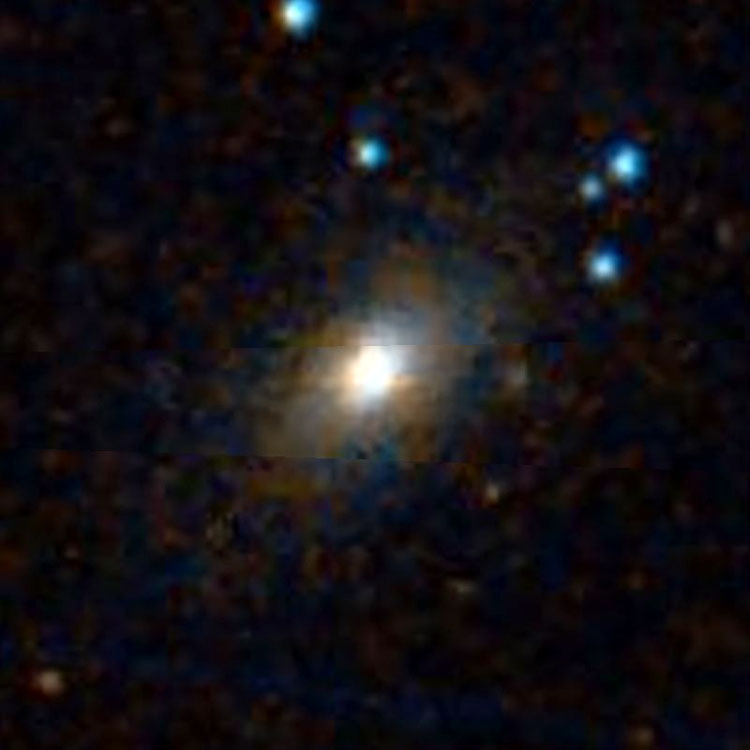
Above, a 2.4 arcmin wide closeup of IC 450
Below, a 12 arcmin wide region centered on the galaxy, also showing IC 451
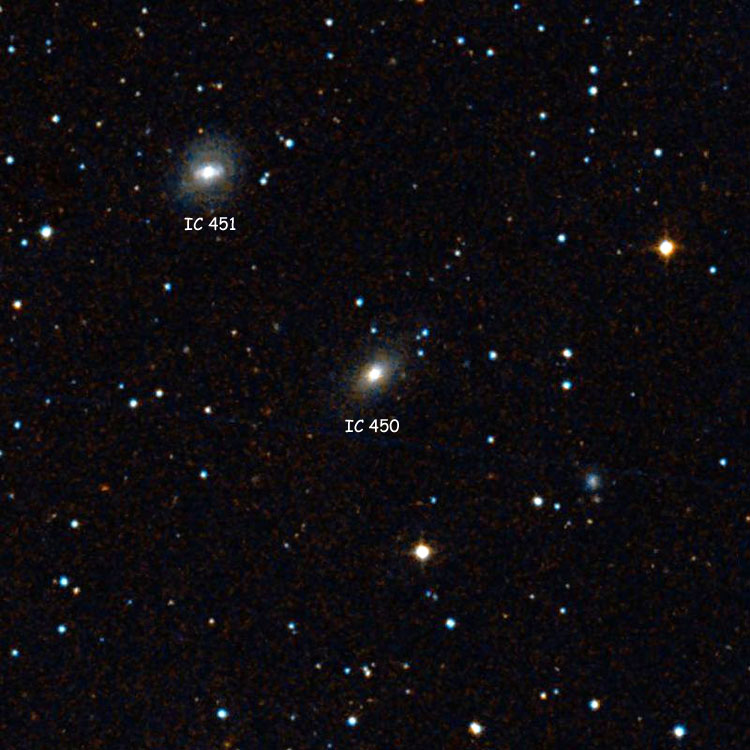
IC 451 (= PGC 19775)
Discovered (1890) by William Denning
A 14th-magnitude spiral galaxy (type SAB(r)b?) in Camelopardalis (RA 06 52 52.0, Dec +74 28 50)
Apparent size 1.15 by 0.95 arcmin. In an apparent pair with IC 450.
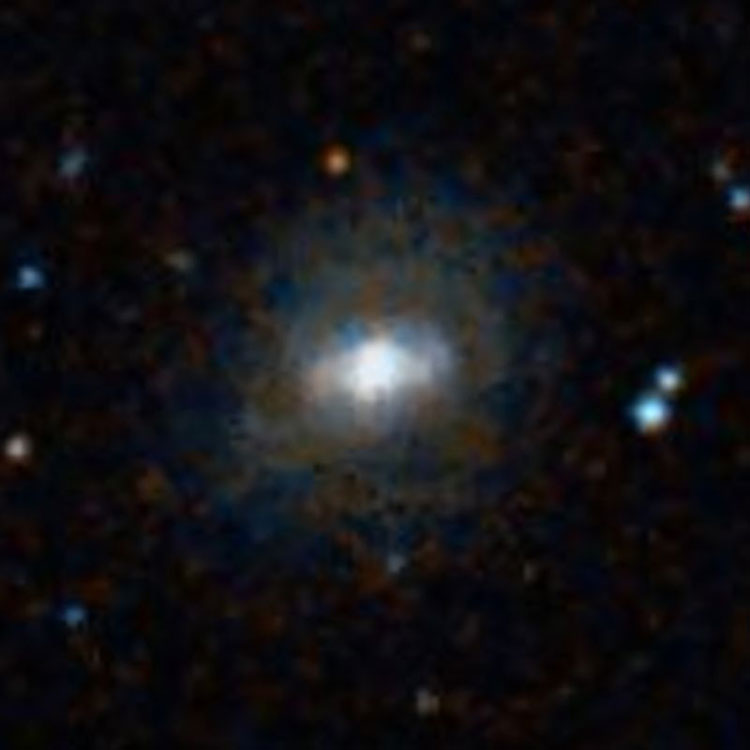
Above, a 2.4 arcmin wide closeup of IC 450
Below, a 12 arcmin wide region centered on the galaxy, also showing IC 450
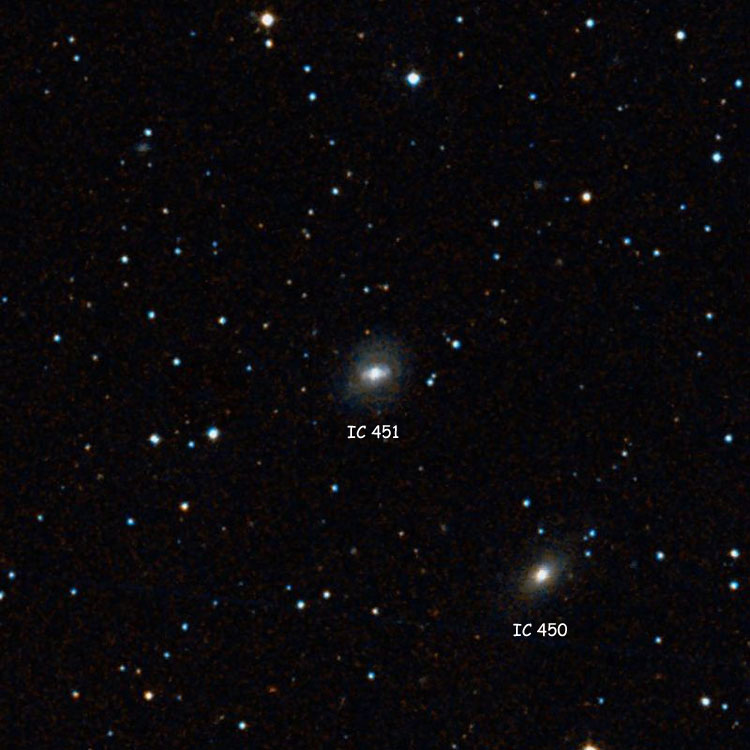
IC 452 (= PGC 19643 = NGC 2296)
Discovered (Mar 11, 1887) by Lewis Swift (and later listed as NGC 2296)
Discovered (Mar 9, 1890) by Guillaume Bigourdan (and later listed as IC 452)
A 12th-magnitude reflection nebula in Canis Major (RA 06 48 39.1, Dec -16 54 06)
Per Dreyer, IC 452 (= Bigourdan #147, 1860 RA 06 42 23, NPD 106 45) is a "13.5 magnitude star in small nebulosity". The position precesses to RA 06 48 37.8, Dec -16 54 14, just southwest of the object, so the identification is certain. For a discussion of the double listing (and anything else) see NGC 2296.
IC 453
Recorded (Mar 9, 1890) by Guillaume Bigourdan (148)
A 15th-magnitude star in Canis Major (RA 06 49 11.4, Dec -16 54 24.4)
Per Dreyer, IC 453 (Bigourdan #148, 1860 RA 06 42 54, NPD 106 53) is a "13th magnitude star in a small nebula, or 2 or 3 close stars". The second IC adds "According to Howe, there is no nebula." The position precesses to RA 06 49 08.4, Dec -17 02 20, which lies in a completely stellar region to the southeast of IC 452. However, it turns out that this is irrelevant, as (per Corwin) Dreyer made an 8 arcmin error in copying Bigourdan's NPD, which should then be 106 45. The corrected position precesses to RA 06 49 08.8, Dec -16 54 20, just west of the star listed above. Corwin notes that Bigourdan mistakenly identified his #148 as NGC 2296, which lies half a minute of time to the west, but his #147 (= IC 452 = NGC 2296) was actually a re-observation of that object. In any event, the relative position of Bigourdan's #147 and 148 (differing by 31 seconds in right ascension, the same as the separation of IC 452 and 453) makes the identification of #148 with the star listed above certain.

Above, a 12 arcmin wide region centered on IC 453
IC 454 (= PGC 19725)
Discovered (Dec 27, 1889) by Lewis Swift (IX-16)
A 13th-magnitude spiral galaxy (type SBab) in Gemini (RA 06 51 06.4, Dec +12 55 18)
Per Dreyer, IC 454 (Swift list IX (#16), 1860 RA 06 43 22, NPD 76 56.0) is "most extremely faint, small, extremely difficult". The second IC adds a corrected RA (per Howe) of 06 43 13, and notes "one or 2 stars involved". The corrected position precesses to RA 06 51 05.5, Dec +12 54 27, less than an arcmin south of the galaxy and there are some foreground stars superimposed on it, so the identification is certain. Apparent size 2.0 by 0.75 arcmin.
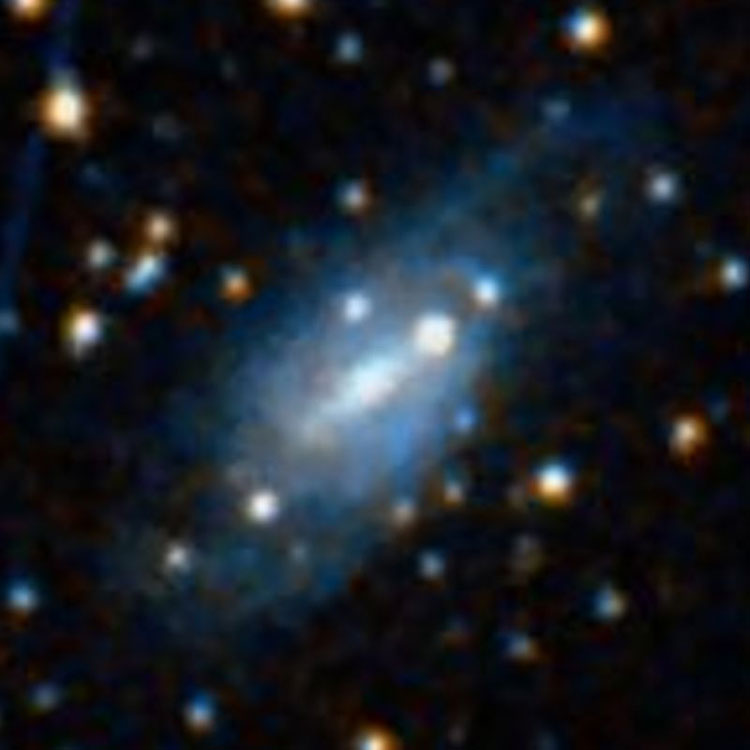
Above, a 2.4 arcmin wide closeup of IC 454
Below, a 12 arcmin wide region centered on the galaxy
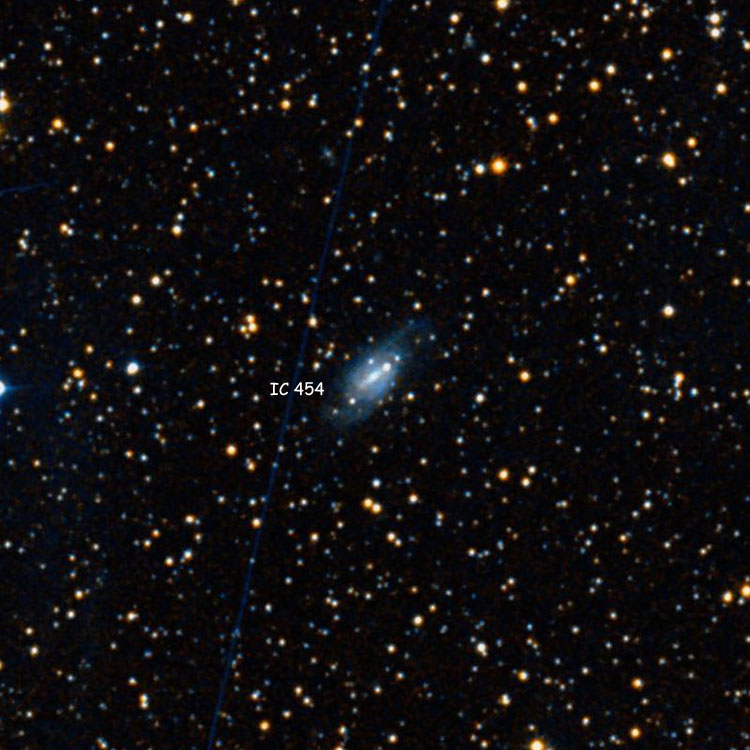
IC 455 (= PGC 21334)
Discovered (Oct 17, 1890) by William Denning (6)
A 13th-magnitude lenticular galaxy (type S0?) in Cepheus (RA 07 34 58.0, Dec +85 32 13)
Apparent size 0.9 by 0.55 arcmin.

Above, a 2.4 arcmin wide closeup of IC 455
Below, a 12 arcmin wide region centered on the galaxy
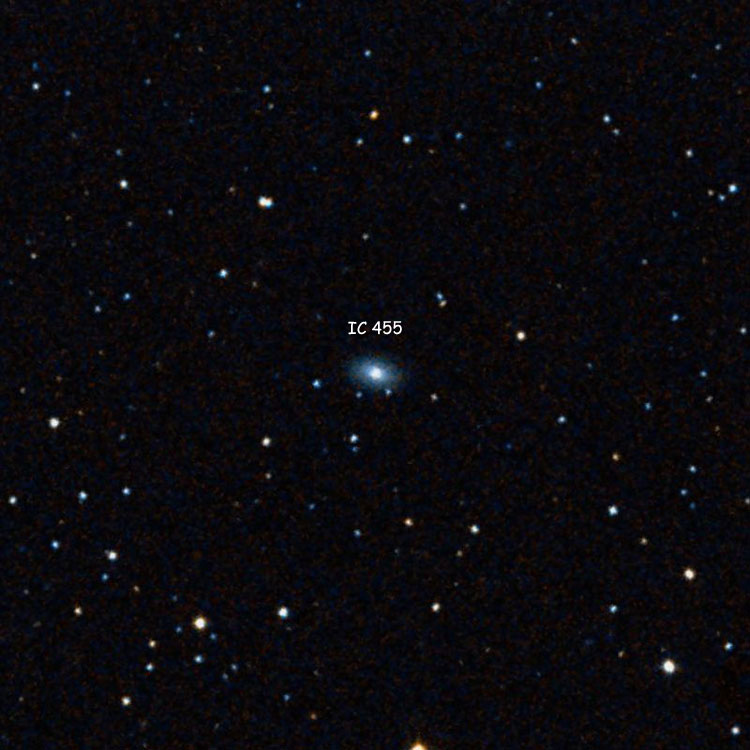
IC 456 (= PGC 19993 = PGC 720635)
Discovered (Dec 19, 1890) by Lewis Swift (X-16)
A 12th-magnitude lenticular galaxy (type SB0°(rs)) in Canis Major (RA 07 00 17.8, Dec -30 09 48)
Apparent size 2.4 by 1.5 arcmin.

Above, a 3 arcmin wide closeup of IC 456
Below, a 12 arcmin wide region centered on the galaxy
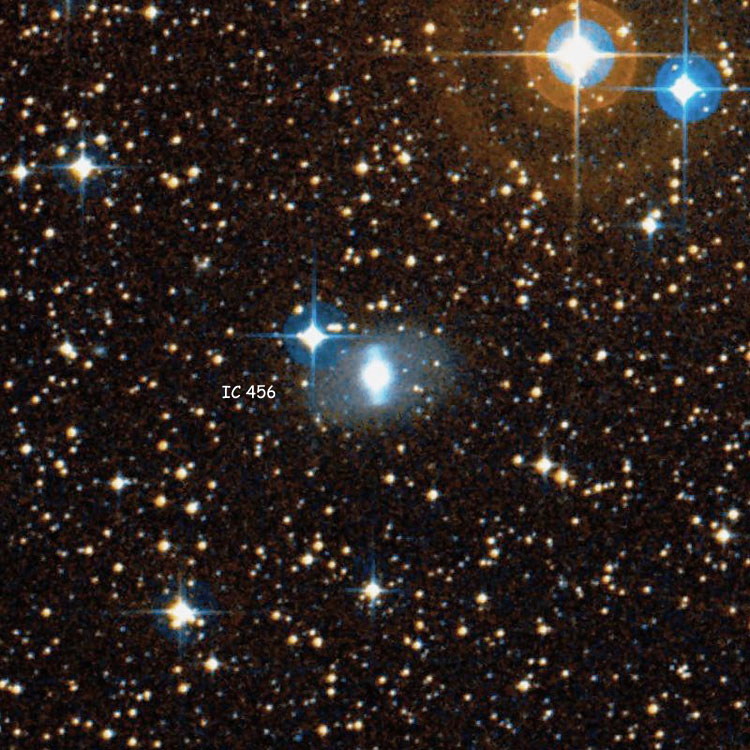
IC 457 (= PGC 20272, and possibly = NGC 2330)
Perhaps discovered (Jan 2, 1851) by Bindon Stoney (and later listed as NGC 2330)
Discovered (Jan 2, 1851) by Bindon Stoney (and later listed as IC 457)
A 15th-magnitude elliptical galaxy (type E3?) in Lynx (RA 07 09 28.4, Dec +50 09 09)
Per Dreyer, IC 457 (3rd Lord Rosse, Kobold, 1860 RA 06 58 42, NPD 39 38.0) is "extremely faint, to southwest of h430", h430 being NGC 2332. The position precesses to RA 07 09 28.5, Dec +50 09 05, right on the galaxy, so the identification is certain. The identification with NGC 2330 (which see for a discussion of the tentative duplicate listing) is not as certain, so although it is traditional to identify objects with duplicate listings by their NGC designation, this object will be covered here until (and unless) its equality with NGC 2330 can be firmly established. Apparent size 0.45 by 0.3 arcmin.
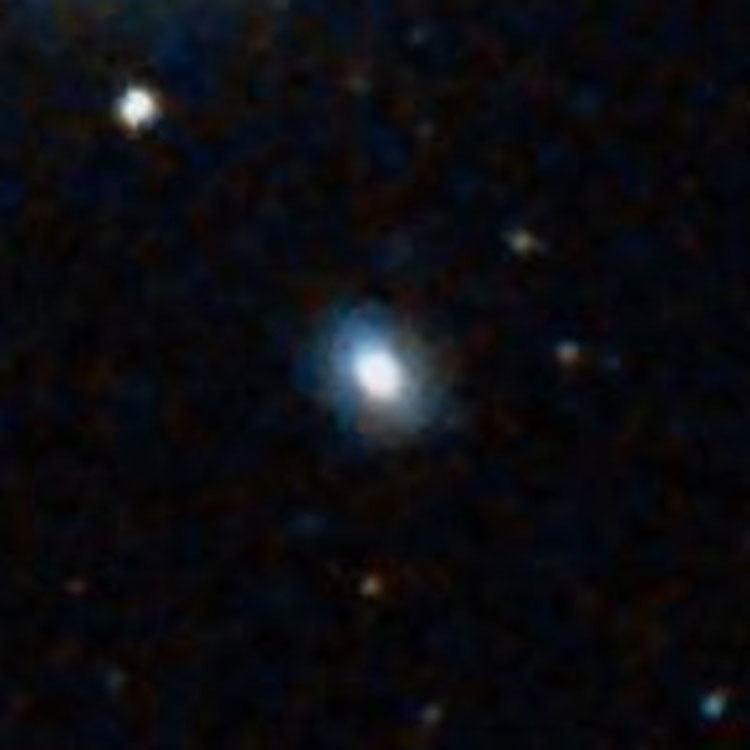
Above, a 2.4 arcmin wide closeup of IC 457
Below, a 12 arcmin wide region centered on the galaxy, also showing NGC 2332
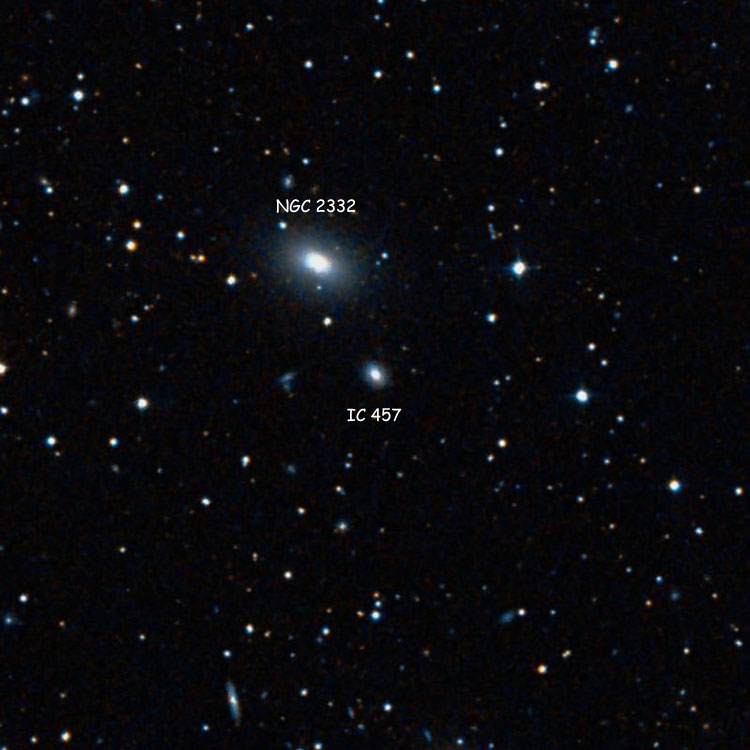
IC 458 (= PGC 20306, and possibly but probably not NGC 2334)
Discovered (Jan 31, 1851) by Bindon Stoney
A 14th-magnitude lenticular galaxy (type E/S0?) in Lynx (RA 07 10 34.0, Dec +50 07 07)
Per Dreyer, IC 458 (3rd Lord Rosse, Swift list VIII, Kobold, 1860 RA 06 59 49, NPD 39 39.7) is "faint, brighter middle".
Apparent size 1.1 by 0.55 arcmin.
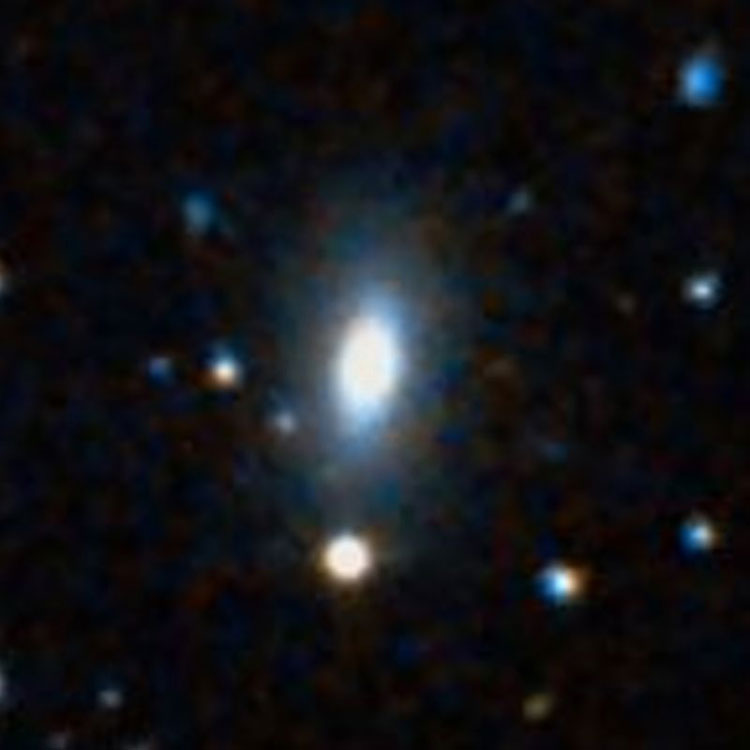
Above, a 2.4 arcmin wide closeup of IC 458
Below, a 12 arcmin wide region centered on the galaxy
Also shown are IC 459, 460, 461, 462, 463, 464 and NGC 2340

IC 459 (= PGC 20311)
Discovered (Jan 31, 1851) by Bindon Stoney
A 15th-magnitude lenticular galaxy (type E/S0?) in Lynx (RA 07 10 38.7, Dec +50 10 38)
Per Dreyer, IC 459 (3rd Lord Rosse, Kobold, 1860 RA 06 59 51, NPD 39 36.2) is "extremely faint".
Apparent size 0.55 by 0.5 arcmin.
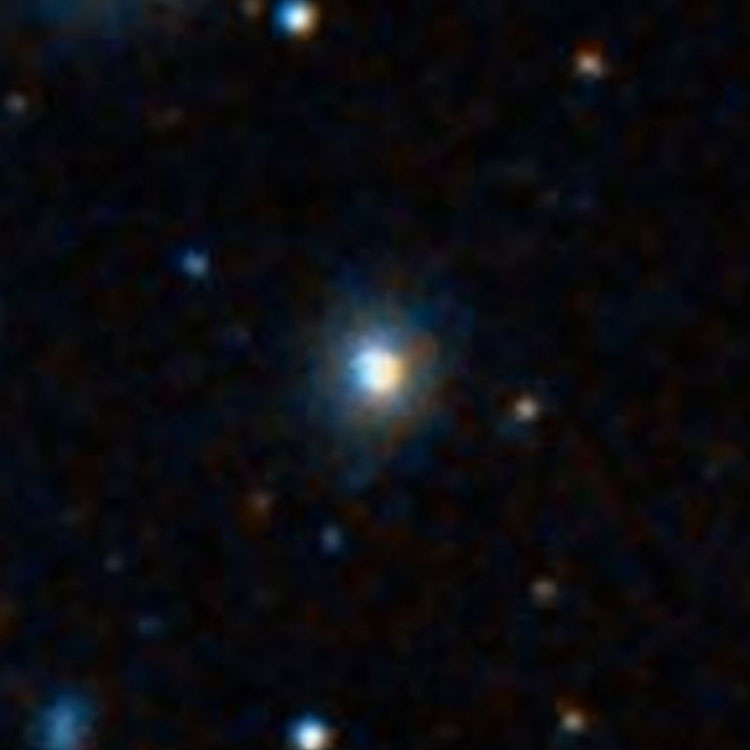
Above, a 2.4 arcmin wide closeup of IC 459
Below, a 12 arcmin wide region centered on the galaxy
Also shown are IC 458, 460, 461, 462, 463, 464 and NGC 2340
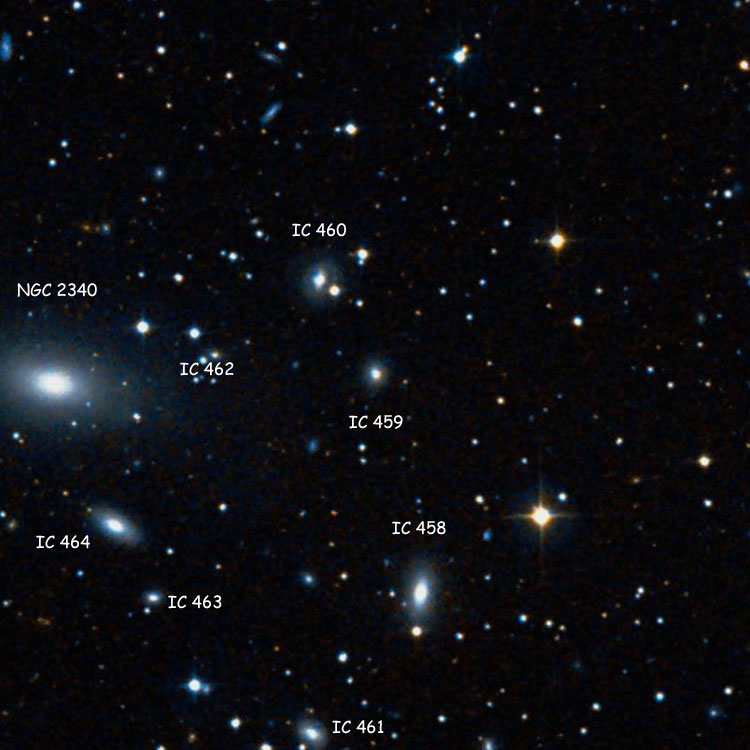
IC 460 (= PGC 20318)
Discovered (Dec 2, 1893) by Hermann Kobold
A 15th-magnitude lenticular galaxy (type (R)E/S0?) in Lynx (RA 07 10 44.2, Dec +50 12 07)
Per Dreyer, IC 460 (Kobold (Nh), 1860 RA 06 59 58, NPD 39 34.7) is "very faint (not seen at Birr)", Birr Castle being the location of Lord Rosse's 72-inch Leviathan.
Apparent size of central brighter region 0.75 by 0.7 arcmin; of fainter halo 1.0 by 1.0 arcmin.

Above, a 2.4 arcmin wide closeup of IC 460
Below, a 12 arcmin wide region centered on the galaxy
Also shown are IC 458, 459, 462, 463, 464 and NGC 2340
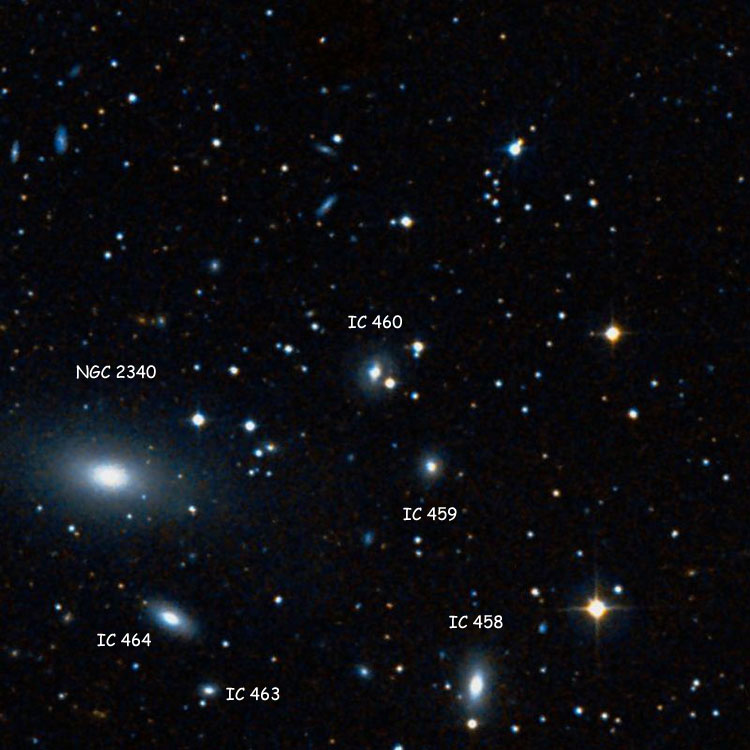
IC 461 (= PGC 20319)
Discovered (Jan 31, 1851) by Bindon Stoney
A 15th-magnitude lenticular galaxy (type S0/a?) in Lynx (RA 07 10 45.0, Dec +50 04 52)
Per Dreyer, IC 461 (3rd Lord Rosse, Swift list VIII, Kobold, 1860 RA 07 01 01, NPD 39 41.9) is "very faint, 3 faint stars to east".
Apparent size 0.65 by 0.5 arcmin.
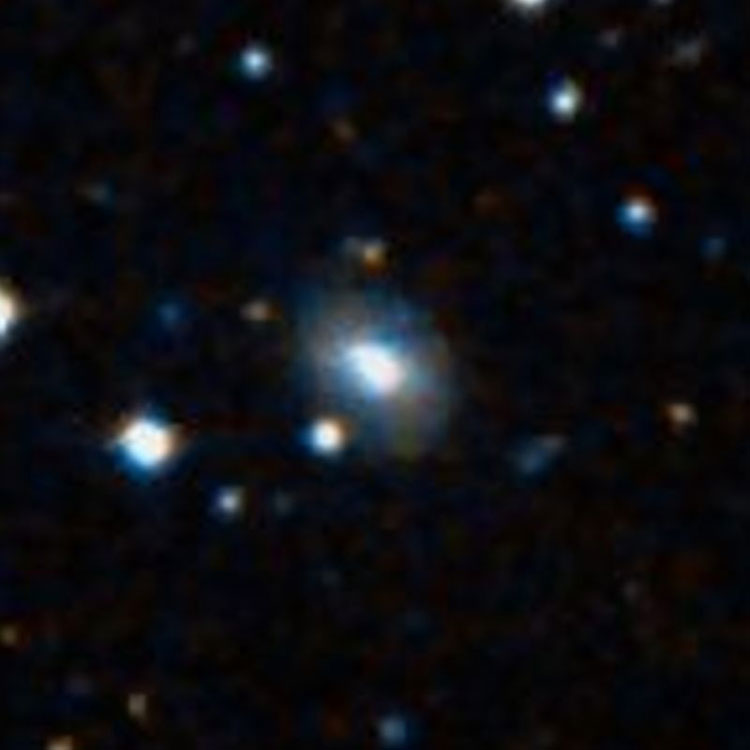
Above, a 2.4 arcmin wide closeup of IC 461
Below, a 12 arcmin wide region centered on the galaxy
Also shown are IC 458, 459, 462, 463, 464 and NGC 2340

IC 462
Recorded (Dec 2, 1893) by Hermann Kobold
A 16th-magnitude star in Lynx (RA 07 10 55.9, Dec +50 10 52)
Per Dreyer, IC 462 (Kobold (Ni), 1860 RA 07 00 11, NPD 39 35.8) is "very faint (not seen at Birr)", Birr Castle being the location of Lord Rosse's 72-inch Leviathan. Per Corwin, the nearby galaxy PGC 2365343, though undoubtedly too faint to have been seen on its own, may have given the star the impression of nebulosity that led Kobold to list it as a nebular object (it is the only one of 9 "novae" he found in the region that is not a nebulous object).
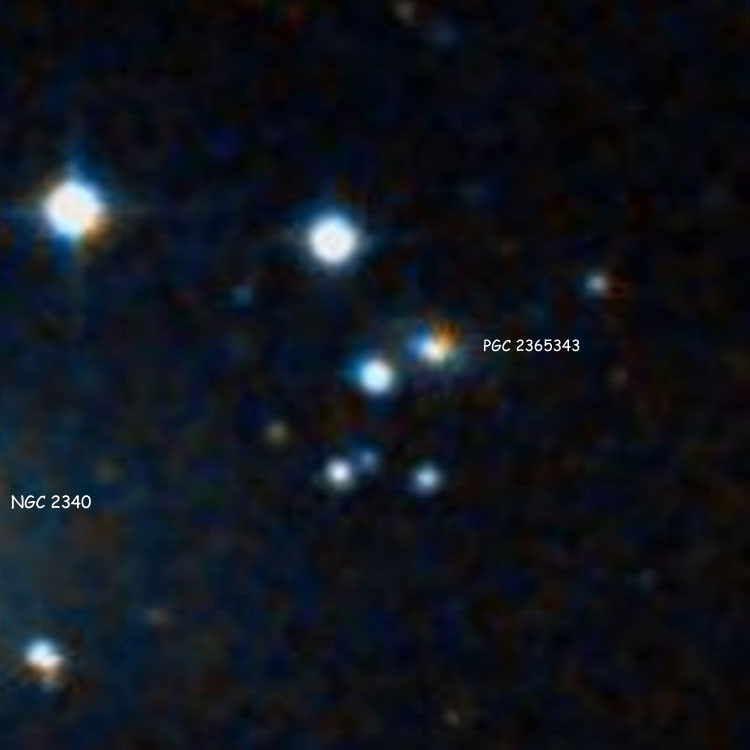
Above, a 2.4 arcmin wide closeup of the star listed as IC 462 and of PGC 2365343
Below, a 12 arcmin wide region centered on the object
Also shown are IC 458, 459, 460, 461, 463, 464, 465 and NGC 2340
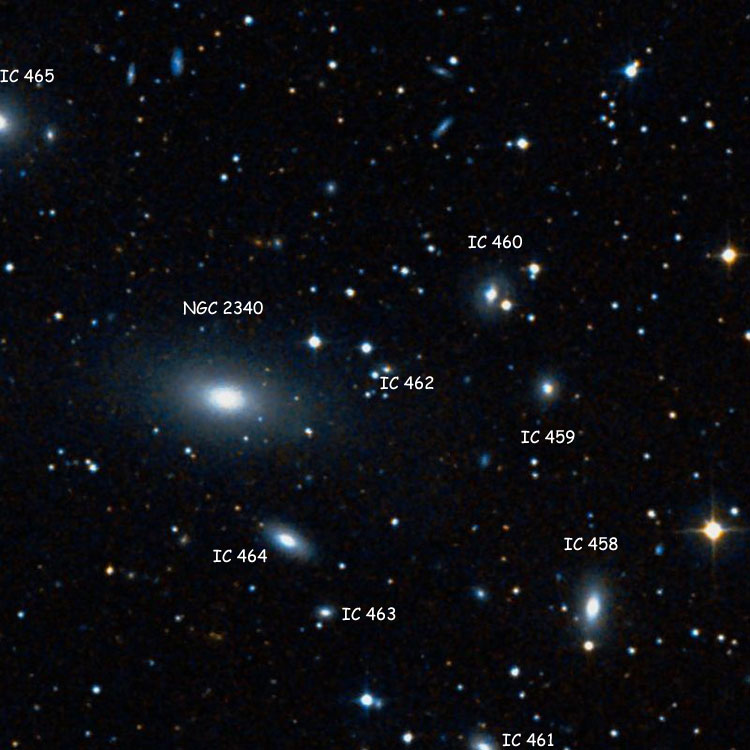
PGC 2365343
Not necessarily an IC object but perhaps part of IC 462
A 17th-magnitude spiral galaxy (type S?) in Lynx (RA 07 10 54.8, Dec +50 10 57)
(See IC 462 for images and a discussion of this galaxy's possible contribution to that entry.) Apparent size 0.25 by 0.15 arcmin. Nothing else known.
IC 463 (= 2MASX J07110091+5007039)
Discovered (Jan 31, 1851) by Bindon Stoney
A 15th-magnitude spiral galaxy (type S?) in Lynx (RA 07 11 00.9, Dec +50 07 02)
Per Dreyer, IC 463 (3rd Lord Rosse, Swift list VIII, Kobold, 1860 RA 07 00 14, NPD 39 39.8) is "extremely faint".
Apparent size 0.35 by 0.25 arcmin.

Above, a 2.4 arcmin wide closeup of IC 463 and 464
Below, a 12 arcmin wide region centered on pair
Also shown are IC 458, 459, 460, 461, 462 and NGC 2340
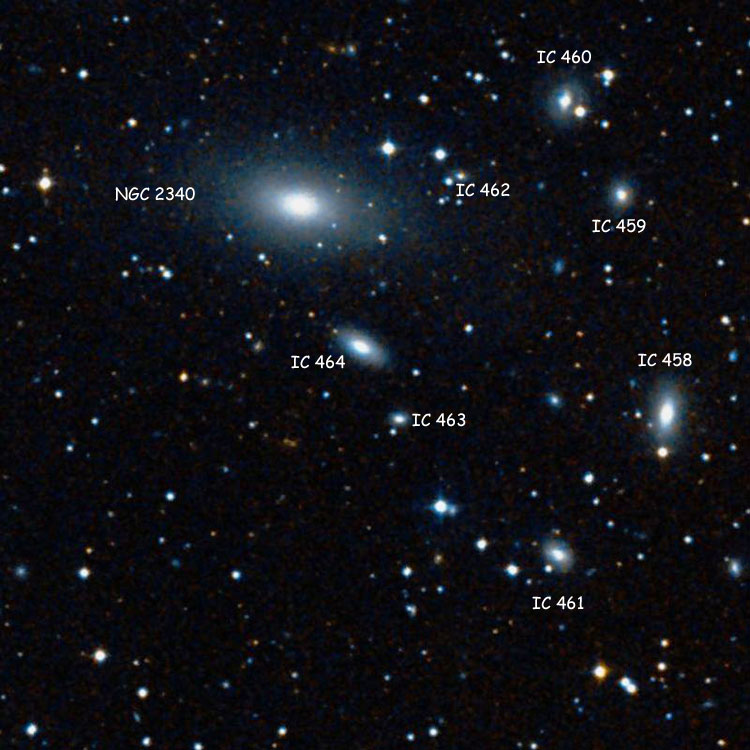
IC 464 (= PGC 20334 = PGC 20332)
Discovered (Jan 31, 1851) by Bindon Stoney
A 14th-magnitude elliptical galaxy (type E5?) in Lynx (RA 07 11 04.7, Dec +50 08 11)
Per Dreyer, IC 464 (3rd Lord Rosse, Kobold, 1860 RA 07 00 19, NPD 39 38.5) is "faint". Apparent size 1.0 by 0.5 arcmin. (See IC 463 for images.)
IC 465 (= PGC 20357, and possibly = NGC 2334)
Discovered (Jan 2, 1851) by Bindon Stoney (and later listed as NGC 2334)
Discovered (Jan 31, 1851) by Bindon Stoney (and later listed as IC 465)
A 14th-magnitude lenticular galaxy (type S0/a?) in Lynx (RA 07 11 33.6, Dec +50 14 53)
Per Dreyer, IC 465 (3rd Lord Rosse, Kobold, 1860 RA 07 00 47, NPD 39 31.7) is "faint". The position precesses to RA 07 11 33.7, Dec +50 14 59, right on the galaxy, so the identification is certain. The identification with NGC 2334 (which see for a discussion of the tentative duplicate listing) is not as certain, so although it is traditional to identify objects with duplicate listings by their NGC designation, this object will be covered here until (and unless) its equality with NGC 2334 can be firmly established. Apparent size 1.2 by 1.1 arcmin.
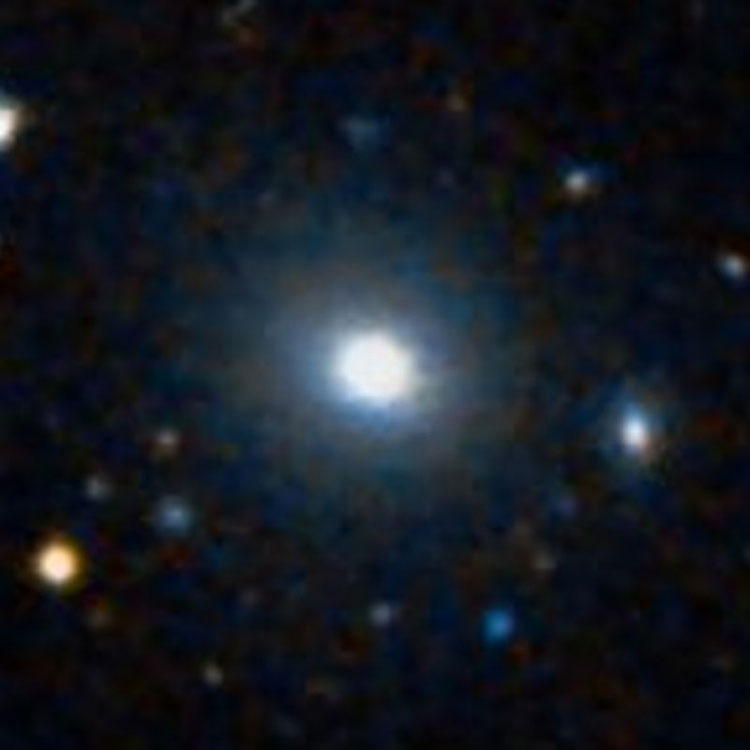
Above, a 2.4 arcmin wide closeup of IC 465
Below, a 12 arcmin wide region centered on the galaxy, also showing NGC 2340
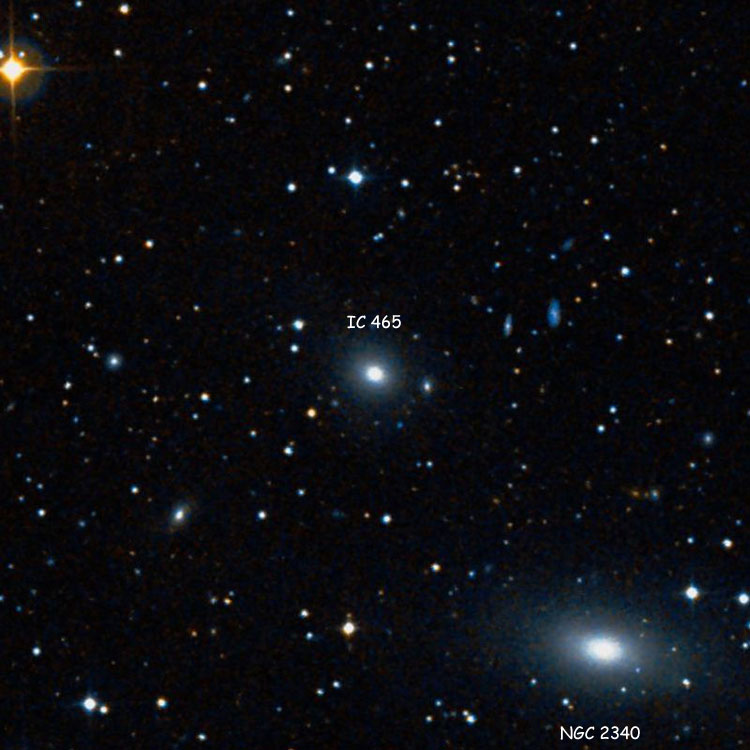
IC 466
Discovered (Feb 18, 1893) by Stephane Javelle
An emission nebula in Monoceros (RA 07 08 39.0, Dec -04 19 05)
Per Dreyer, IC 466 (Javelle #616, 1860 RA 07 01 42, NPD 94 06.2) is an "11.5 magnitude star in a very faint nebula". Apparent size 3.0 by 2.1 arcmin. (The original IC object may have only have comprised the brighter central portion of the extended nebulosity.)
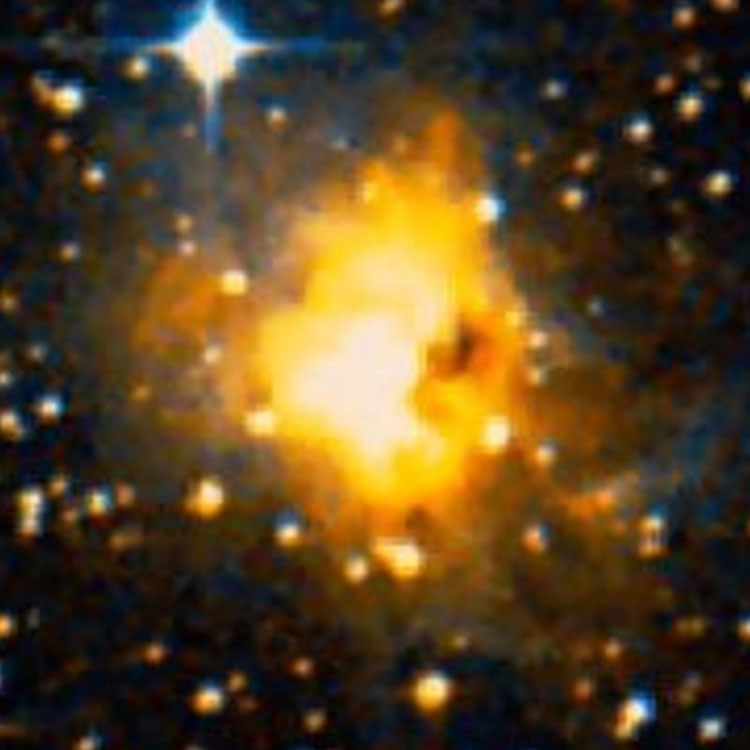
Above, a 3 arcmin wide closeup of IC 466
Below, a 12 arcmin wide region centered on the nebula

IC 467 (= PGC 21164)
Discovered (Nov 7, 1890) by William Denning
A 13th-magnitude spiral galaxy (type SABc) in Camelopardalis (RA 07 30 18.3, Dec +79 52 21)
Per Dreyer, IC 467 (Denning #7, 1860 RA 07 03 38, NPD 09 49.7) is "very faint, pretty small, south-southeast of (NGC) 2336". Apparent size 2.95 by 1.1 arcmin.
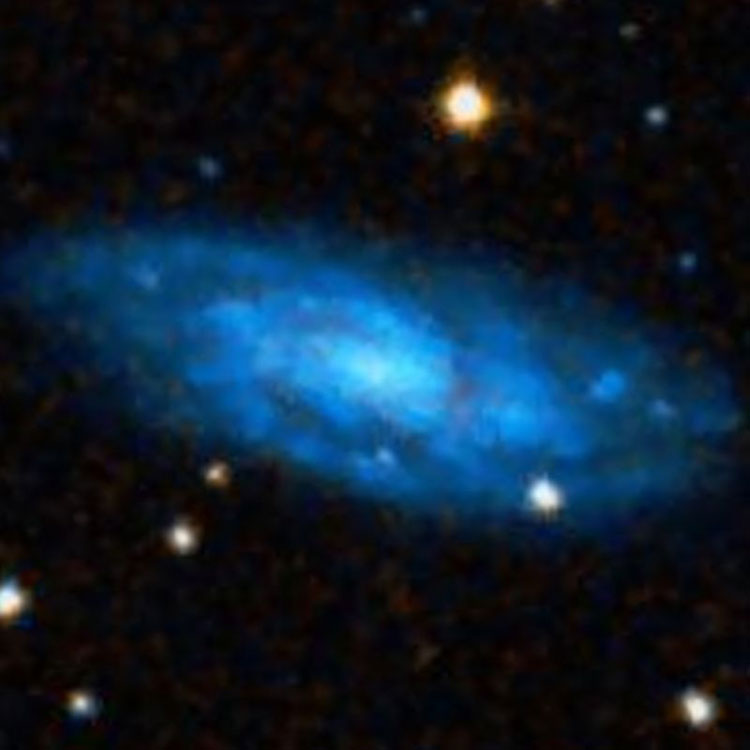
Above, a 3 arcmin wide closeup of IC 467
Below, a 12 arcmin wide region centered on the nebula
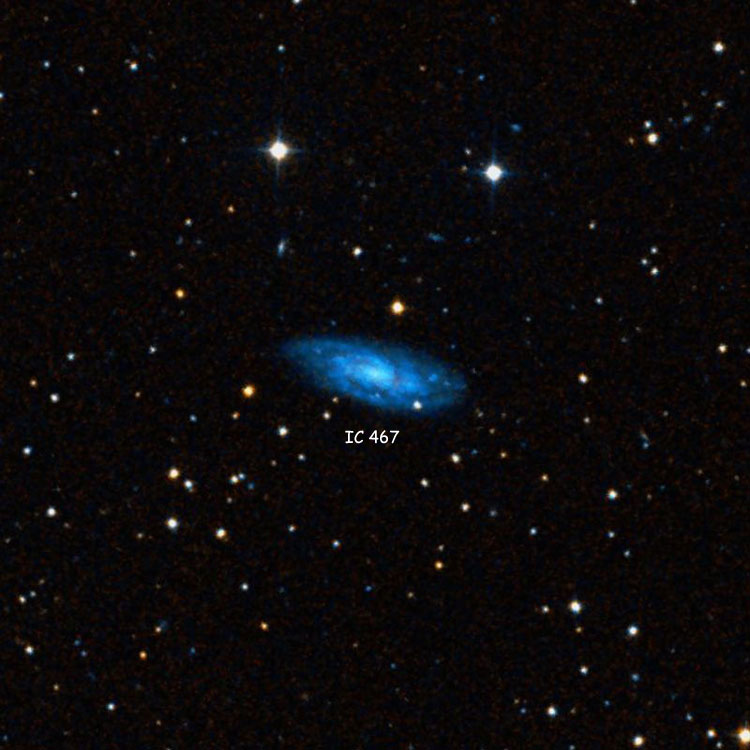
IC 468
Recorded (Feb 25, 1887) by Guillaume Bigourdan
A group of stars in Canis Major (near RA 07 17 19.0, Dec -13 13 08 ?)
Per Dreyer, IC 468 (Bigourdan #149, 1860 RA 07 10 52, NPD 102 55) is a "very faint nebulosity, perhaps 2 or 3 stars involved". The second IC adds "Not found by Howe (3 nights)." The position precesses to RA 07 17 21.2, Dec -13 09 52, but there is nothing there save for scattered stars. Corwin and Thomson state that the object is the group of stars listed above, which lie 4 arcmin south of the IC position, but which per their statements agree well with the the first of two positions measured by Bigourdan, so the IC entry must have misrepresented that position. (Note to self: Check Bigourdan's original records for the next iteration of this page.) Thomson also notes that Bigourdan's remarks for the second observation state that he doubts that there is any nebulosity involved, but that position recorded for that observation lies well to the west of the first, so it probably refers to a different stellar group. As a result the position of IC 468 seems more than a little uncertain, but it is certainly some insignificant group of stars.
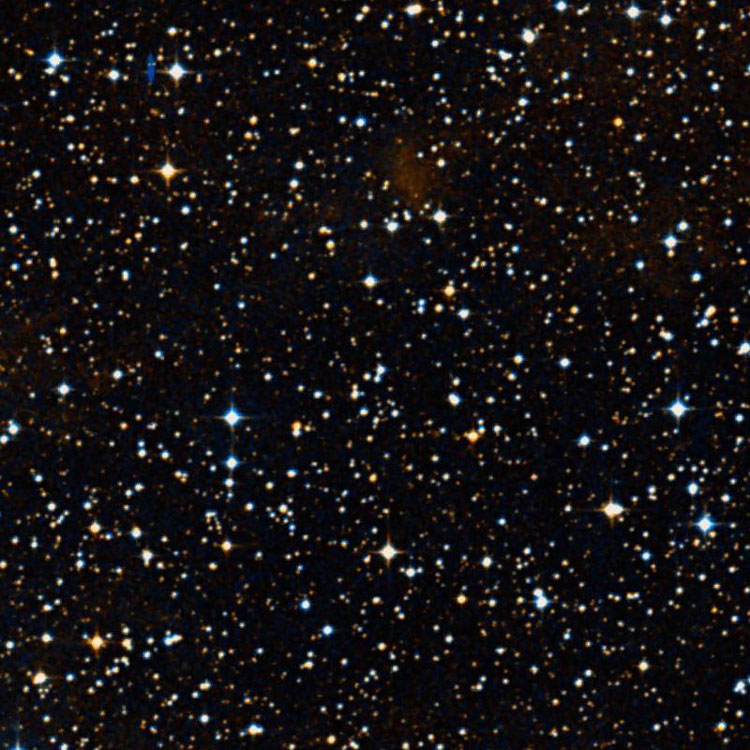
Above, a 12 arcmin wide region centered on the listed (Corwin's) position for IC 468
IC 469 (= PGC 22213)
Discovered (Sep 14, 1890) by William Denning (8)
A 13th-magnitude spiral galaxy (type SAB(rs)ab?) in Cepheus (RA 07 55 59.3, Dec +85 09 31)
Apparent size 2.35 by 0.85 arcmin.
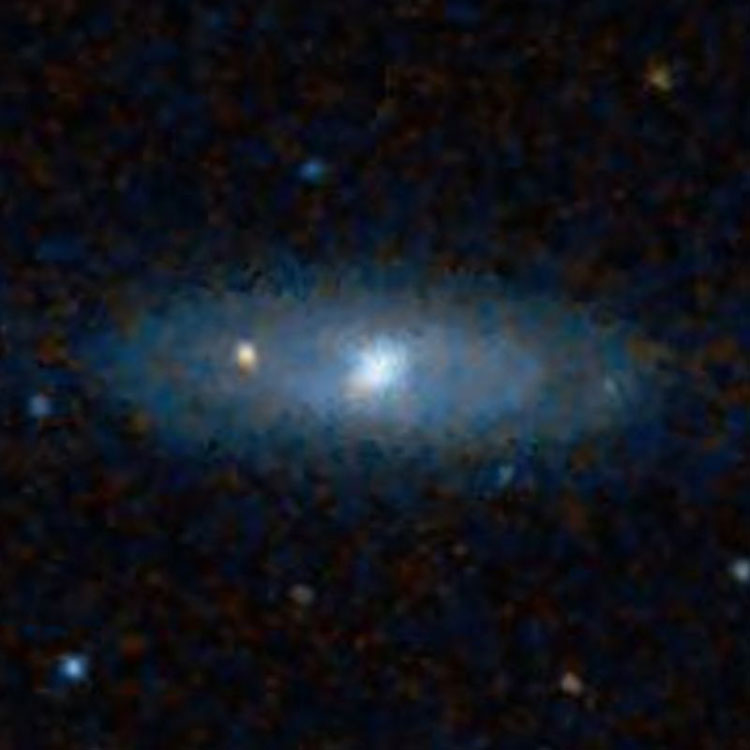
Above, a 3 arcmin wide closeup of IC 469
Below, a 12 arcmin wide region centered on the galaxy

IC 470
Recorded (Oct 2, 1891) by Lewis Swift
A 13th-magnitude double star in Lynx (RA 07 23 31.6, Dec +46 04 44)
Per Dreyer, IC 470 (Swift list X (#17), 1860 RA 07 13 18, NPD 43 39.8) is "extremely faint, extremely small, stellar". The position precesses to RA 07 23 32.1, Dec +46 04 30, but there is nothing there save for scattered stars. Per Corwin, the very close double listed above, which lies only a quarter of an arcmin to the north of Swift's position, is about the right brightness to have looked like a faint nebula to Swift on a night of poor seeing, and is most likely to be what he observed.

Above, a 12 arcmin wide region centered on the double star that is probably IC 470
IC 471 (= PGC 21659)
Discovered (Apr 20, 1890) by Lewis Swift (IX-17)
A 13th-magnitude elliptical galaxy (type E1?) in Lynx (RA 07 43 36.4, Dec +49 40 05)
Apparent size 1.2 by 1.1 arcmin. Apparently in a pair with IC 472.
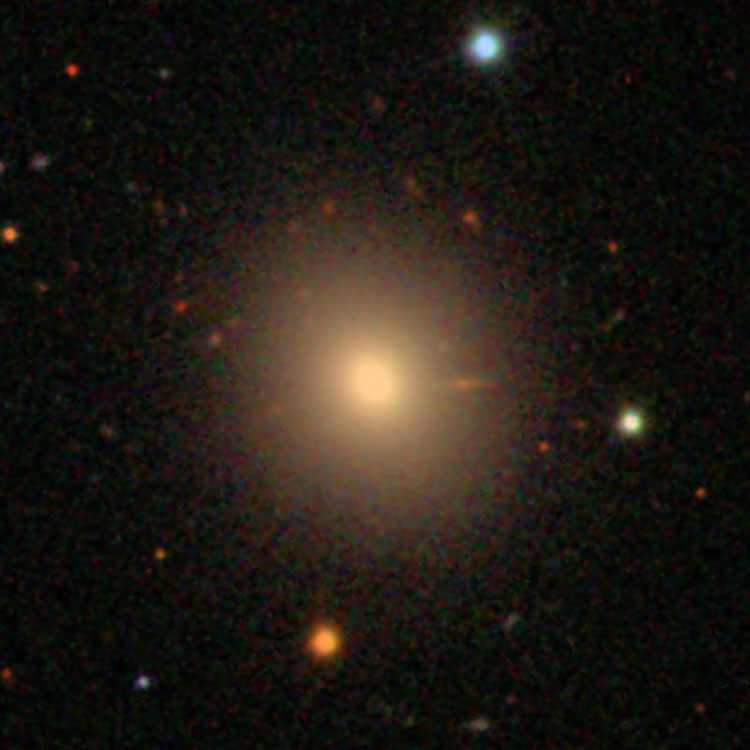
Above, a 2.4 arcmin wide closeup of IC 471
Below, a 12 arcmin wide region centered on the galaxy, also showing IC 472
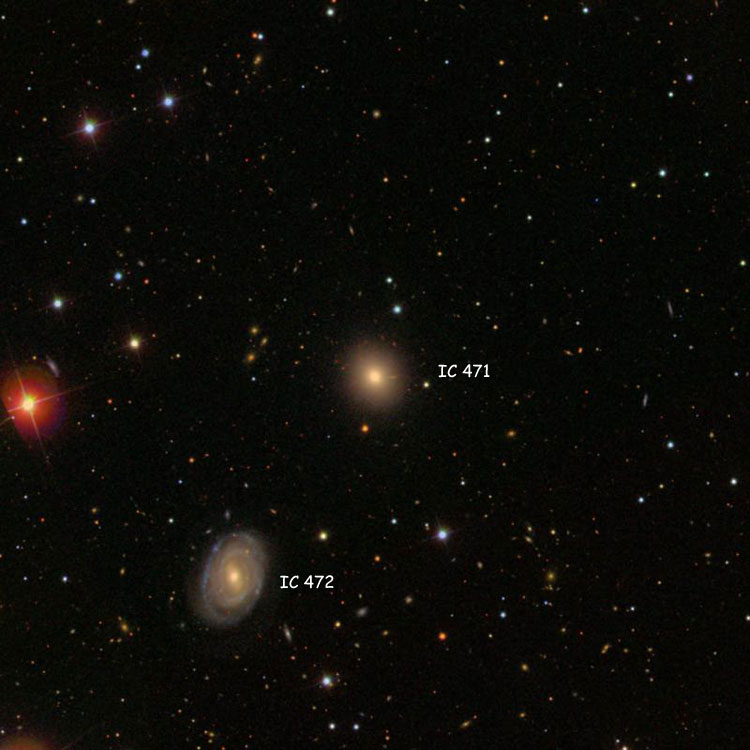
IC 472 (= PGC 21665)
Discovered (Apr 20, 1890) by Lewis Swift (IX-18)
A 13th-magnitude spiral galaxy (type SAB(rs)b) in Lynx (RA 07 43 50.2, Dec +49 36 50)
Apparent size 1.7 by 1.1 arcmin. Apparently in a pair with IC 471.
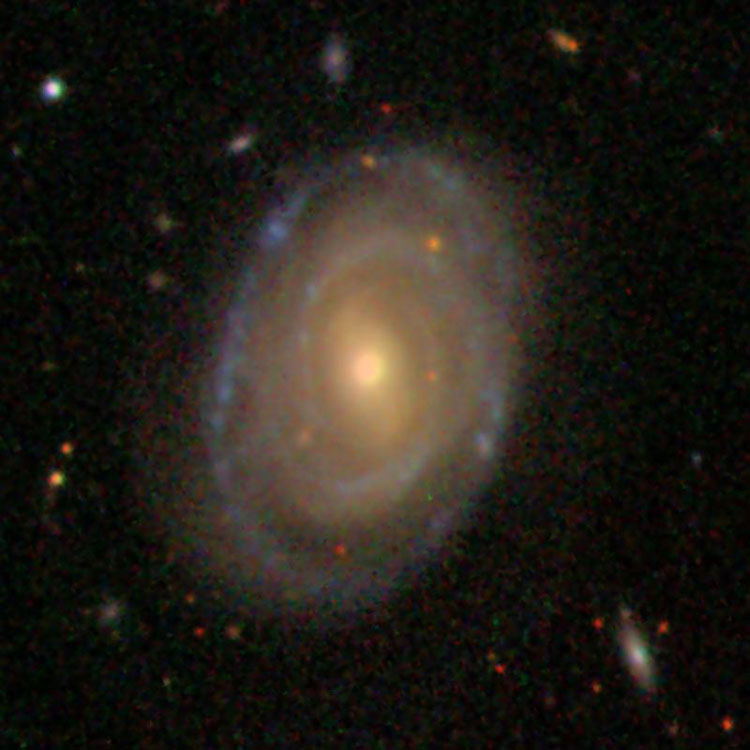
Above, a 2.4 arcmin wide closeup of IC 472
Below, a 12 arcmin wide region centered on the galaxy, also showing IC 471

IC 473
Recorded (Apr 3, 1891) by Rudolf Spitaler
Probably a 14th-magnitude double star in Canis Minor (RA 07 42 24.6, Dec +09 15 19)
Per Dreyer, IC 473 (Spitaler #9, 1860 RA 07 34 46, NPD 80 25.5) is a "nebulous 14th magnitude star, h462 to northeast", h462 being NGC 2433. The position precesses to RA 07 42 24.5, Dec +09 15 00, just south of the double star listed above, but the triple star listed as NGC 2433 is five arcminutes due east, not northeast. The double star could easily have appeared to be a nebulous star to Spitaler, so the main problem with its identification as IC 473 is the apparently incorrect location of NGC 2433. As noted in the entry for that object, Spitaler confirmed Herschel's position for NGC 2433 as being correct, so it appears that he should have listed it as being to the east of IC 473, suggesting that perhaps the identification of IC 473 is not as certain as it might otherwise appear to be. However, there is nothing in the area to the southwest of NGC 2433 save scattered stars, so even if one or more of those were to be identified as the "correct" IC 473, the fact that the entry refers to a stellar rather than a nebulous object would remain unchanged.

Above, a 12 arcmin wide region centered on IC 473, also showing NGC 2433
IC 474 (= PGC 21749)
Discovered (Jan 30, 1892) by Stephane Javelle (136)
A 14th-magnitude spiral galaxy (type Sa?) in Gemini (RA 07 46 07.3, Dec +26 30 16)
Apparent size 1.1 by 0.35 arcmin.
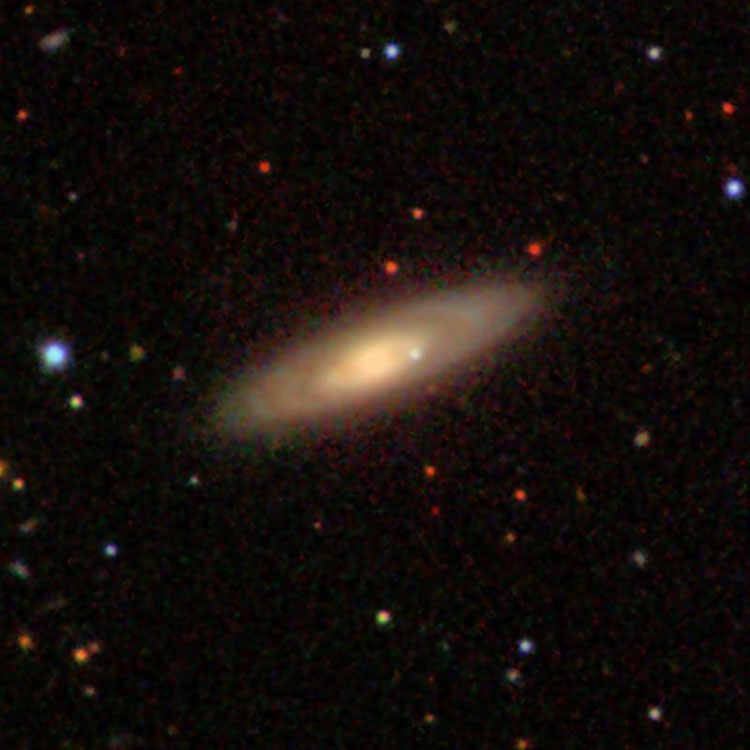
Above, a 2.4 arcmin wide closeup of IC 474
Below, a 12 arcmin wide region centered on the galaxy

IC 475 (= PGC 21795)
Discovered (Feb 17, 1892) by Stephane Javelle (137)
A 15th-magnitude spiral galaxy (type S(r)bc?) in Gemini (RA 07 47 09.2, Dec +30 29 20)
Apparent size 0.8 by 0.55 arcmin.
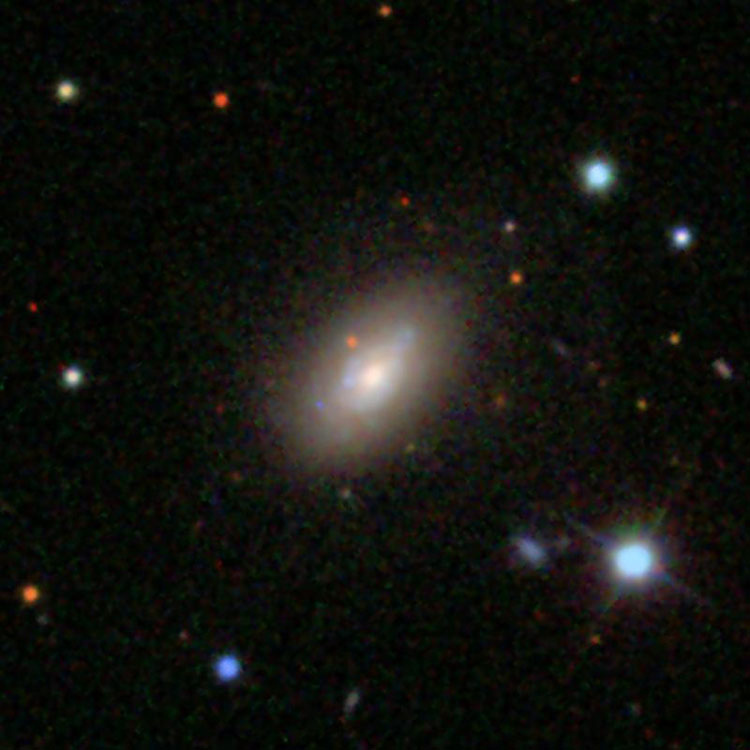
Above, a 2.4 arcmin wide closeup of IC 475
Below, a 12 arcmin wide region centered on the galaxy

IC 476 (= PGC 21796)
Discovered (Jan 30, 1892) by Stephane Javelle (138)
A 15th-magnitude spiral galaxy (type SABbc?) in Gemini (RA 07 47 16.4, Dec +26 57 03)
Apparent size 0.6 by 0.5 arcmin.
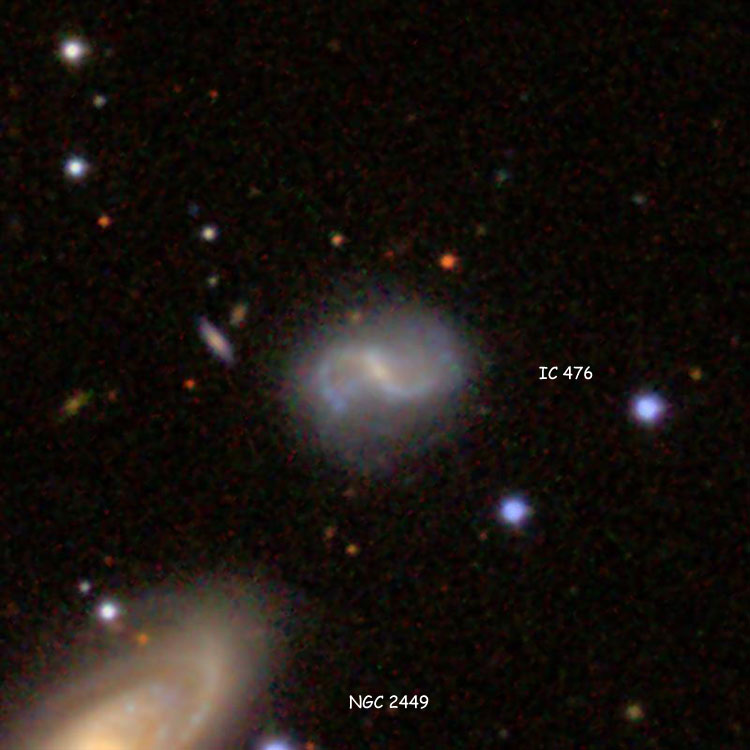
Above, a 2.4 arcmin wide closeup of IC 476, also showing part of NGC 2449
Below, a 12 arcmin wide region centered on the galaxy, also showing NGC 2449 and 2450 and IC 2205
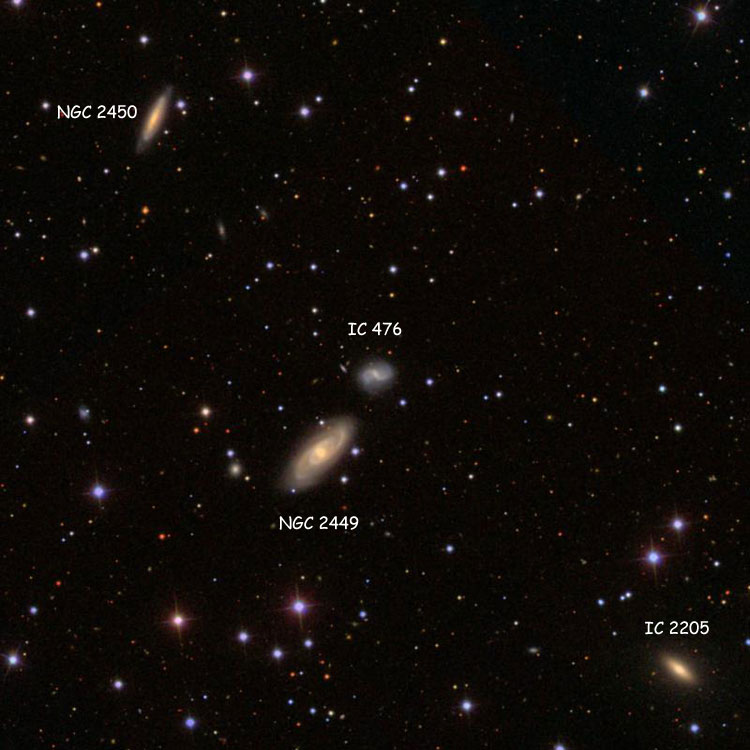
IC 477 (= PGC 22037)
Discovered (Feb 17, 1892) by Stephane Javelle (139)
A 14th-magnitude elliptical galaxy (type E0?) in Gemini (RA 07 52 06.9, Dec +23 29 01)
Apparent size 0.9 by 0.9 arcmin.

Above, a 2.4 arcmin wide closeup of IC 477
Below, a 12 arcmin wide region centered on the galaxy
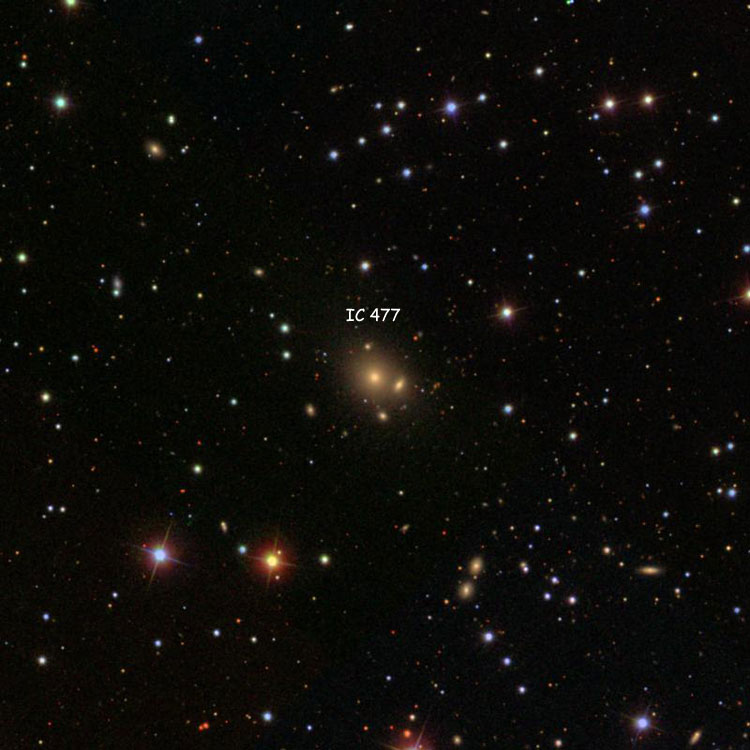
IC 478 (= PGC 22109)
Discovered (Mar 2, 1892) by Stephane Javelle (140)
A 14th-magnitude spiral galaxy (type Sb pec?) in Gemini (RA 07 53 41.6, Dec +26 29 32)
Apparent size 0.65 by 0.4 arcmin.

Above, a 2.4 arcmin wide closeup of IC 478
Below, a 12 arcmin wide region centered on the galaxy
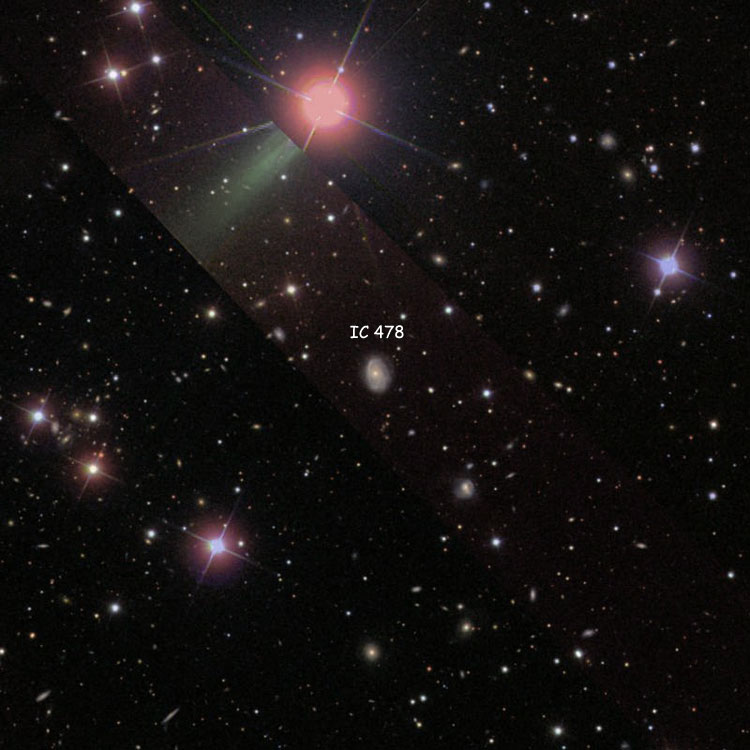
IC 479 (= PGC 22138)
Discovered (Mar 2, 1892) by Stephane Javelle (141)
A 15th-magnitude spiral galaxy (type SABc?) in Gemini (RA 07 54 22.3, Dec +27 00 30)
Apparent size 0.6 by 0.45 arcmin.

Above, a 2.4 arcmin wide closeup of IC 479
Below, a 12 arcmin wide region centered on the galaxy

IC 480 (= PGC 22188)
Discovered (Mar 18, 1892) by Stephane Javelle (142)
A 14th-magnitude spiral galaxy (type Sbc?) in Gemini (RA 07 55 23.1, Dec +26 44 32)
Apparent size 1.95 by 0.35 arcmin.
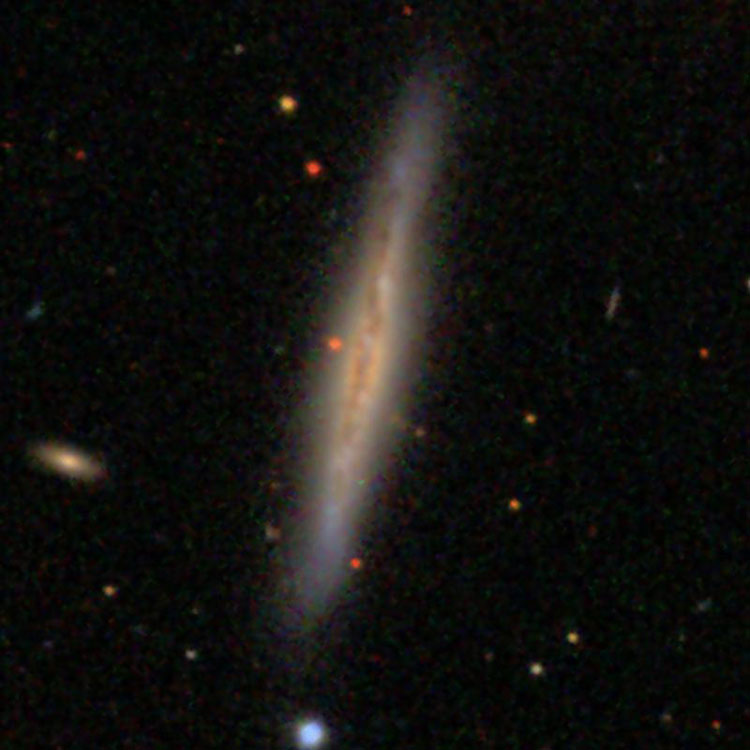
Above, a 2.4 arcmin wide closeup of IC 480
Below, a 12 arcmin wide region centered on the galaxy
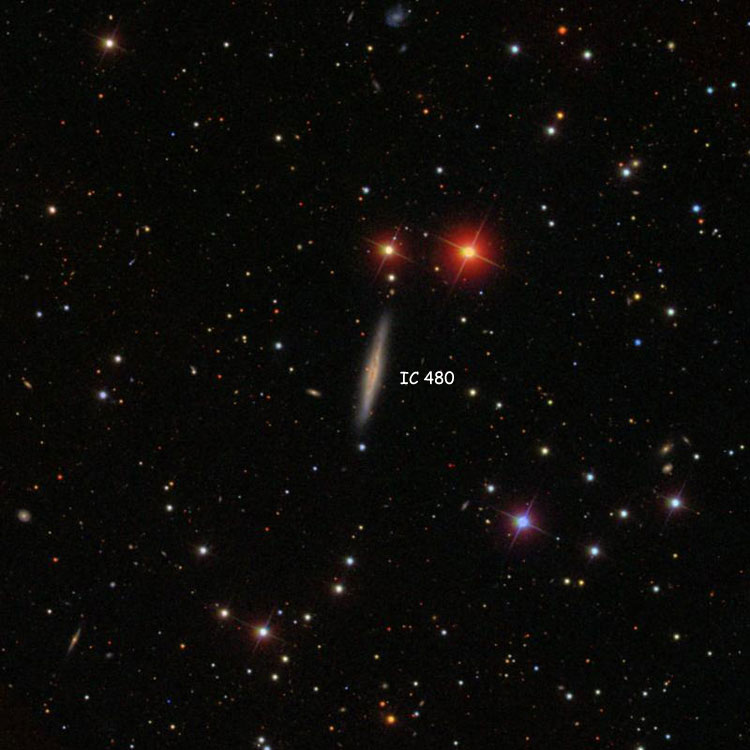
IC 481 (= PGC 22374)
Discovered (Mar 2, 1892) by Stephane Javelle (143)
A 14th-magnitude spiral galaxy (type Sbc?) in Gemini (RA 07 59 02.8, Dec +24 09 37)
Apparent size 1.05 by 0.3 arcmin.

Above, a 2.4 arcmin wide closeup of IC 481
Below, a 12 arcmin wide region centered on the galaxy
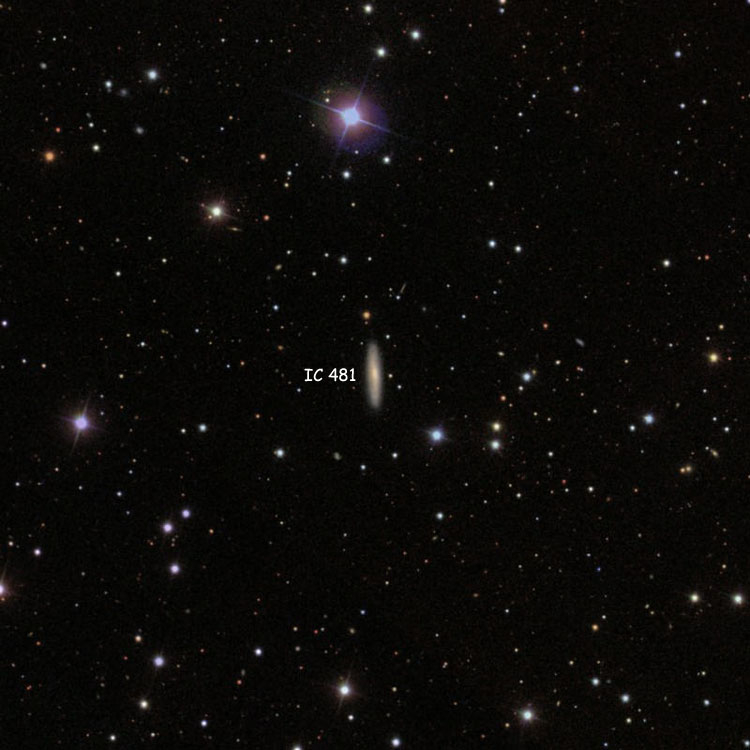
IC 482 (= PGC 22409)
Discovered (Mar 2, 1892) by Stephane Javelle (144)
A 15th-magnitude spiral galaxy (type Sc?) in Gemini (RA 07 59 47.3, Dec +25 21 22)
Apparent size 0.7 by 0.5 arcmin.

Above, a 2.4 arcmin wide closeup of IC 482
Below, a 12 arcmin wide region centered on the galaxy

IC 483
Recorded (Feb 8, 1891) by Rudolf Spitaler
A pair of 15th-magnitude stars in Gemini (RA 07 59 52.3, Dec +25 55 32)
Per Dreyer, IC 483 (Spitaler #10, 1860 RA 07 51 22, NPD 63 42.0) is "faint, small, brighter middle, faint star to northeast". The position precesses to RA 07 59 52.5, Dec +25 55 24, practically on the pair of stars listed above, and the 13th-magnitude star to their northeast appears to make the identity certain.

Above, a 12 arcmin wide region centered on the stars listed as IC 483
IC 484 (= PGC 22419)
Discovered (Mar 6, 1891) by Rudolf Spitaler (11)
A 15th-magnitude spiral galaxy (type SABab?) in Gemini (RA 08 00 01.0, Dec +26 39 57)
Apparent size 0.85 by 0.5 arcmin.

Above, a 2.4 arcmin wide closeup of IC 484
Below, a 12 arcmin wide region centered on the galaxy, also showing IC 485 and 486

IC 485 (= PGC 22443)
Discovered (Mar 6, 1891) by Rudolf Spitaler (12a)
A 15th-magnitude spiral galaxy (type Sa?) in Gemini (RA 08 00 19.8, Dec +26 42 06)
Apparent size 1.35 by 0.3 arcmin.

Above, a 2.4 arcmin wide closeup of IC 485
Below, a 12 arcmin wide region centered on the galaxy, also showing IC 484 and 486
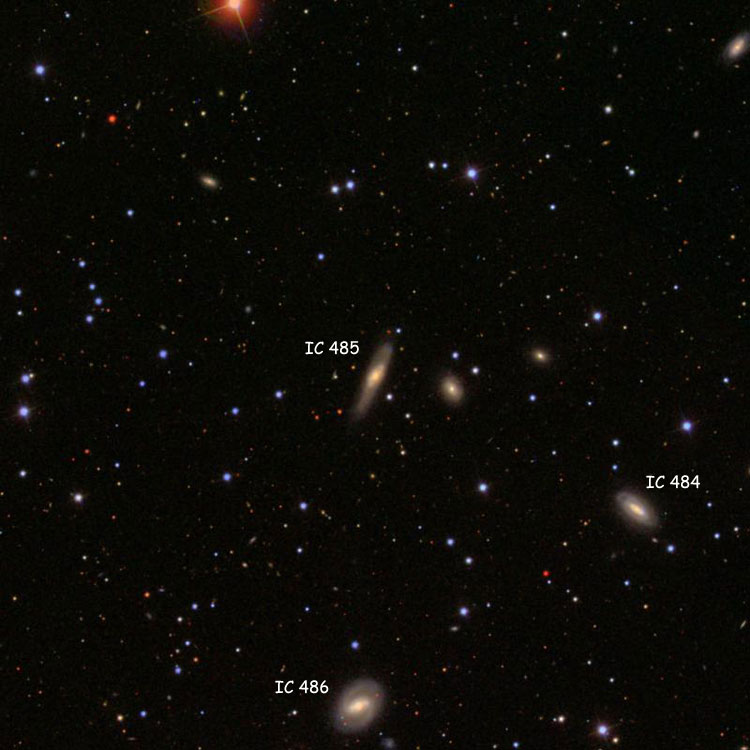
IC 486 (= PGC 22445)
Discovered (Mar 6, 1891) by Rudolf Spitaler (12)
A 14th-magnitude spiral galaxy (type SBa?) in Gemini (RA 08 00 21.1, Dec +26 36 48)
Apparent size 1.0 by 0.7 arcmin.
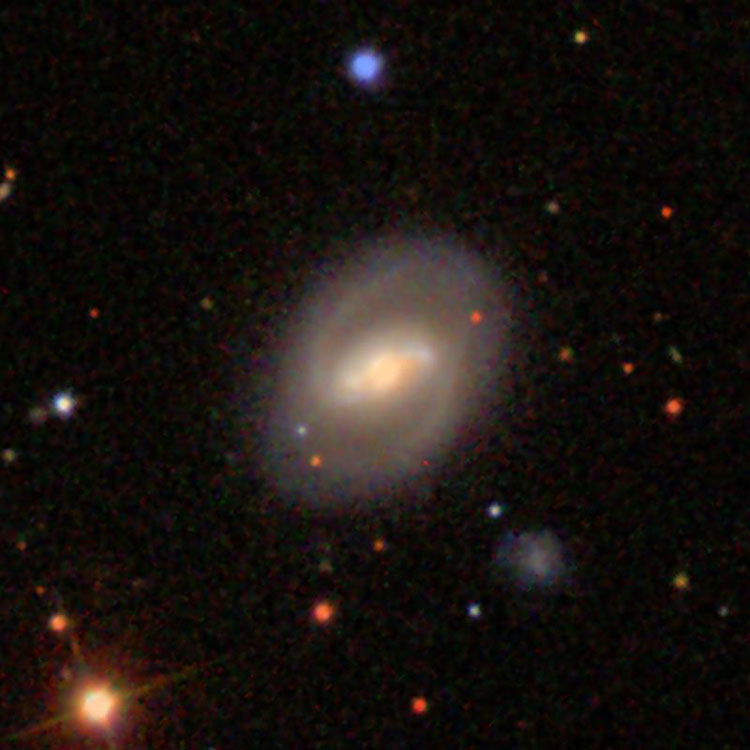
Above, a 2.4 arcmin wide closeup of IC 486
Below, a 12 arcmin wide region centered on the galaxy, also showing IC 485 and 486

IC 487 (= NGC 2494 = PGC 22377)
Discovered (Feb 6, 1864) by Albert Marth (and later listed as NGC 2494)
Discovered (Feb 3, 1888) by Lewis Swift (and later listed as IC 487)
A 13th-magnitude lenticular galaxy (type (R')SB0/a(rs)) in Monoceros (RA 07 59 07.2, Dec -00 38 15)
Per Dreyer, IC 487 (Swift list VII (#10), 1860 RA 07 52 03, NPD 90 17.0) is "most extremely faint, very small, round". The second IC adds (per Howe) "Not round, but extended 110°". The position precesses to RA 07 59 11.9, Dec -00 39 36, a couple of arcmin to the southeast of NGC 2494, which is not only the only nebular object in the region, but extended more or less east and west, as described by Howe, so the identification with that object seems certain. Per Corwin, the double listing is probably due to the fact that Marth's position was off by a full minute of time, enough that neither Swift, Howe nor Dreyer realized that the IC listing was a duplication of the NGC entry (which see for anything else).
IC 488
Recorded (Feb 8, 1891) by Rudolf Spitaler
A pair of 15th- and 16th-magnitude stars in Cancer (RA 08 00 49.7, Dec +25 54 10)
Per Dreyer, IC 488 (Spitaler #13, 1860 RA 07 52 19, NPD 63 42.8) is "very faint, small, diffuse, 13th magnitude star to southwest". The position precesses to RA 08 00 49.3, Dec +25 54 25, in a region with no nebulosity, so IC 488 must be one or more of the stars near the position. The most likely candidate for the IC object is the pair of stars listed above, which lies only a quarter of an arcmin south-southeast of Spitaler's position, and the 13th-magnitude star less than 3 arcmin to their southwest seems to confirm the identification. Per Corwin, there are some problems with internal inconsistencies in Spitaler's measurements, so although this seems by far the most likely identification, it cannot be said to be certain. For instance, Spitaler's "nova" might have included the trio of 15th- and 16th-magnitude stars just to the east of the pair in question, in which case the identification would be with the small grouping, rather than merely the pair of stars closest to his position. However, if that were the case Spitaler would probably have stated that the object was somewhat elongated, so as already stated the pair of stars seems the best guess as to what he observed. In any event, the object is certainly not the nebula he thought it to be.
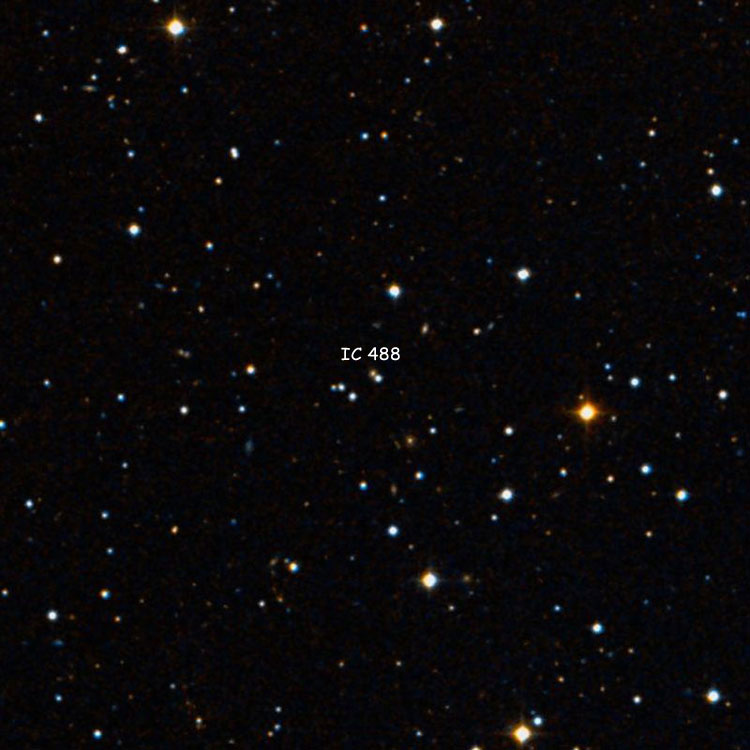
Above, a 12 arcmin wide region centered on the pair of stars most likely to be IC 488
IC 489
Recorded (Feb 8, 1891) by Rudolf Spitaler (14)
A 15th-magnitude star in Cancer (RA 08 01 37.8, Dec +25 59 48)
Per Dreyer, IC 489 (Spitaler #14, 1860 RA 07 53 07, NPD 63 34) is "very faint, very small, suddenly brighter middle". The second IC adds (per the Wiener Annalen xi, 125) a corrected NPD of 63 37.2. The corrected position precesses to RA 08 01 37.5, Dec +25 59 53, just northwest of the star listed above, and given Spitaler's description the identification seems certain. Per Corwin, Spitaler's original measurement (which provided the original IC position) was based on offsets from BD+26 1704, for which he had no accurate position. By the time of his paper in the Wiener Annalen, he had obtained an accurate position for the comparison star, so Dreyer was able to publish a corrected NPD in the IC2.

Above, a 12 arcmin wide region centered on the star listed as IC 489
IC 490 (= PGC 22607)
Discovered (Mar 2, 1892) by Stephane Javelle (148)
A 15th-magnitude spiral galaxy (type SABbc(r)) in Cancer (RA 08 03 20.1, Dec +25 48 40)
Apparent size 0.55 by 0.35 arcmin.

Above, a 2.4 arcmin wide closeup of IC 490
Below, a 12 arcmin wide region centered on the galaxy

IC 491 (= PGC 22631)
Discovered (Mar 18, 1892) by Stephane Javelle
A 15th-magnitude spiral galaxy (type Sc pec?) in Cancer (RA 08 03 55.1, Dec +26 31 12)
Per Dreyer, IC 491 (Javelle #149, 1860 RA 07 55 22, NPD 63 05.9) is "very faint, extremely small, round". The position precesses to RA 08 03 53.9, Dec +26 30 47, due south of a pair of 15th- and 16th-magnitude galaxies. It seems certain that the brighter galaxy (PGC 22631, as noted above) is part or all of what Javelle observed, but whether the fainter one ( PGC 1779405) should be considered part of the IC object is another matter. It is merely an optical double with PGC 22631, as it has a recessional velocity that puts it at least twice as far away, but it may still have contributed to what Javelle observed. (It would probably take visual observations comparable to those performed by Javelle to decide, and I can find no mention of any effort to attempt them.) Apparent size 0.65 by 0.3 arcmin.
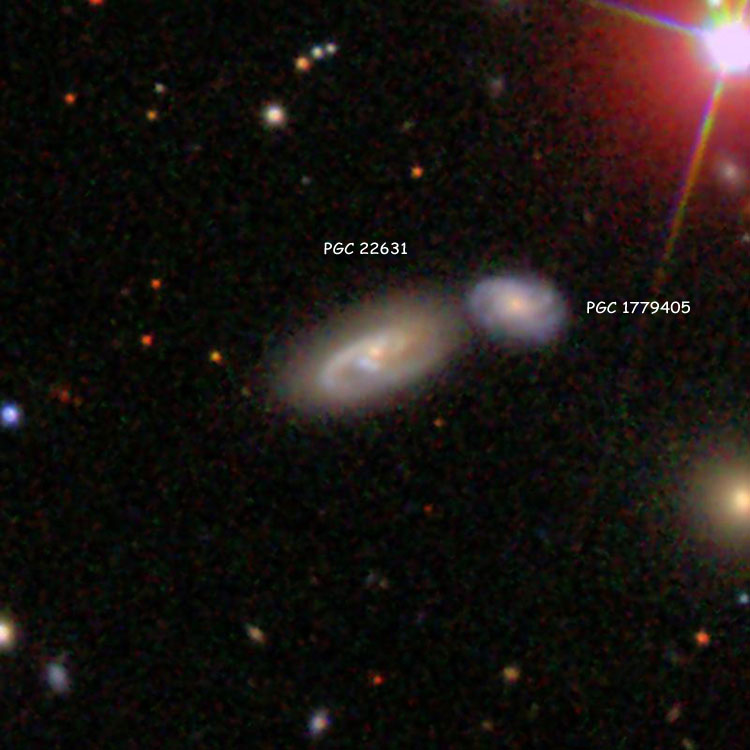
Above, a 2.4 arcmin wide closeup of PGC 22631 and 1779405, one or both of which comprise IC 491
Below, a 12 arcmin wide region centered on the galaxy
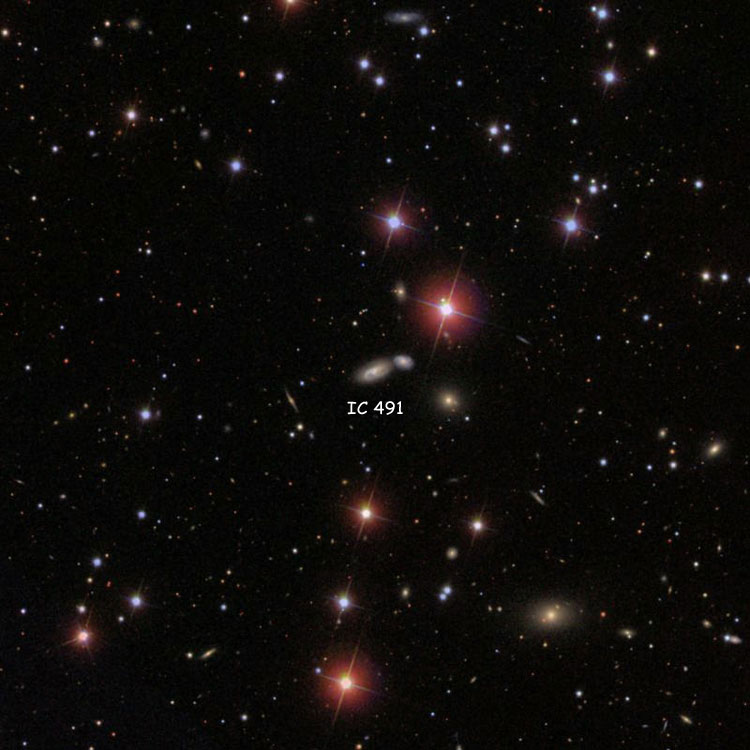
PGC 1779405 (possibly = part of IC 491)
A 16th-magnitude spiral galaxy (type Sc?) in Cancer (RA 08 03 53.0, Dec +26 31 23)
An optical double with PGC 22631, and possibly part of IC 491 (which see for images). Apparent size 0.3 by 0.2 arcmin.
IC 492 (= PGC 22724)
Discovered (Feb 5, 1891) by Edward Barnard
A 14th-magnitude spiral galaxy (type SB(s)bc?) in Cancer (RA 08 05 38.4, Dec +26 10 03)
Per Dreyer, IC 492 (Javelle #150, Barnard [3038], Spitaler #15, 1860 RA 07 57 09, NPD 63 26.5) is "pretty bright, very gradually brighter middle, extended north-south, 13.5 magnitude star to southeast" (Barnard [3038] referring to a paper in Astronomische Nachrichten #3038 in which Barnard states that the 13.5 magnitude star is only 1/4 arcmin away). The position precesses to RA 08 05 39.3, Dec +26 09 52, practically on top of the galaxy, and the star immediately to its southeast, though considerably fainter than stated, makes the identification certain.
Apparent size 1.1 by 1.0 arcmin.

Above, a 2.4 arcmin wide closeup of IC 492
Below, a 12 arcmin wide region centered on the galaxy

IC 493 (= PGC 22795)
Discovered (Mar 2, 1892) by Stephane Javelle (151)
A 14th-magnitude spiral galaxy (type SABab?) in Cancer (RA 08 07 27.6, Dec +25 08 01)
Apparent size 0.9 by 0.65 arcmin.
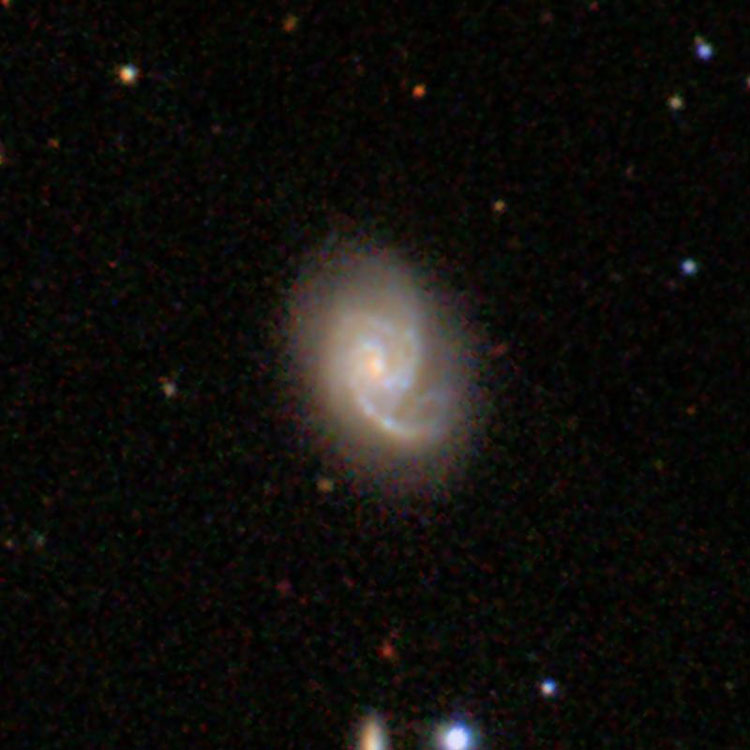
Above, a 2.4 arcmin wide closeup of IC 493
Below, a 12 arcmin wide region centered on the galaxy
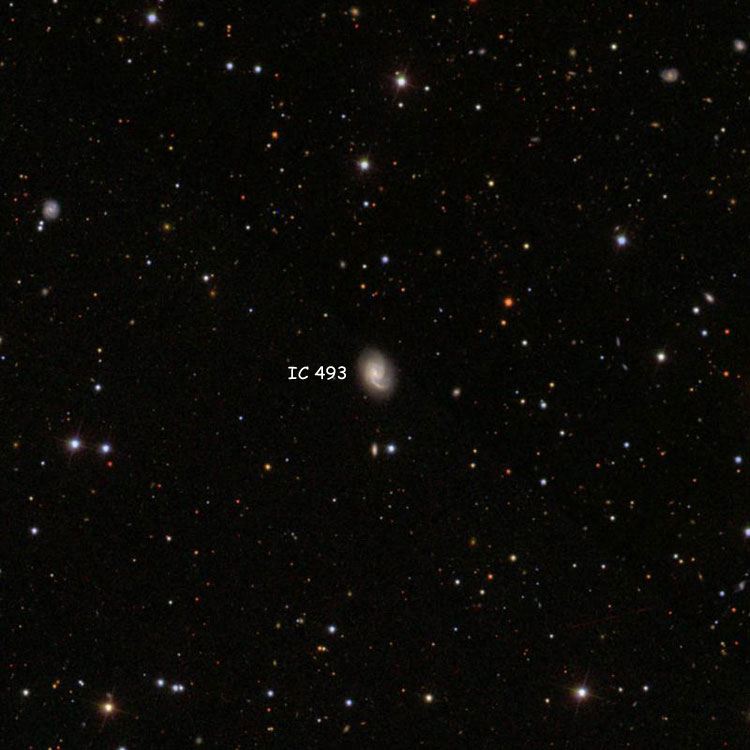
IC 494 (= PGC 22755)
Discovered (Dec 12, 1888) by Guillaume Bigourdan (150)
A 13th-magnitude spiral galaxy (type S0/a?) in Canis Minor (RA 08 06 24.3, Dec +01 02 12)
Apparent size 1.5 by 0.7 arcmin.
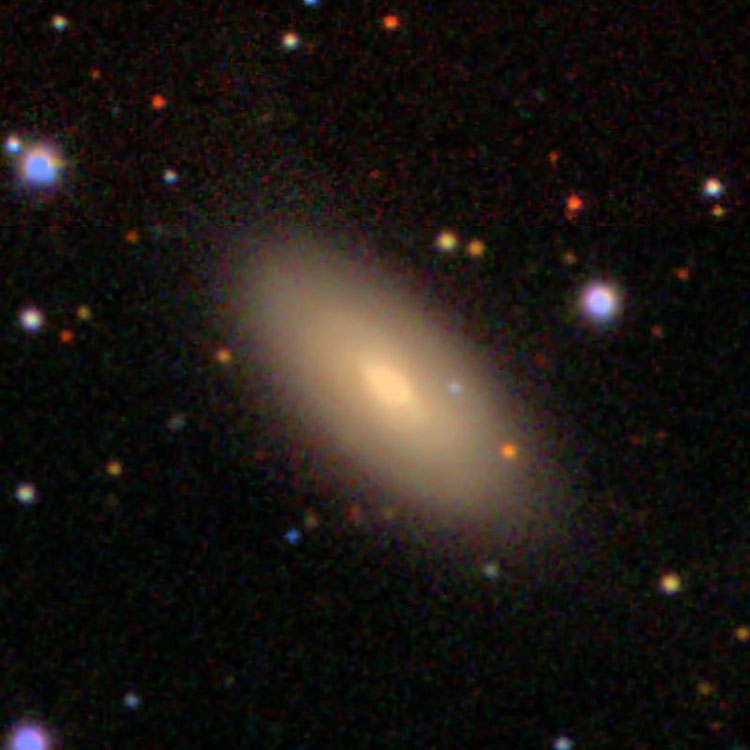
Above, a 2.4 arcmin wide closeup of IC 494
Below, a 12 arcmin wide region centered on the galaxy

IC 495 (= PGC 22841)
Discovered (Mar 9, 1893) by Stephane Javelle (617)
A 14th-magnitude elliptical galaxy (type E4 pec?) in Cancer (RA 08 08 19.4, Dec +09 00 52)
Apparent size 0.9 by 0.55 arcmin.
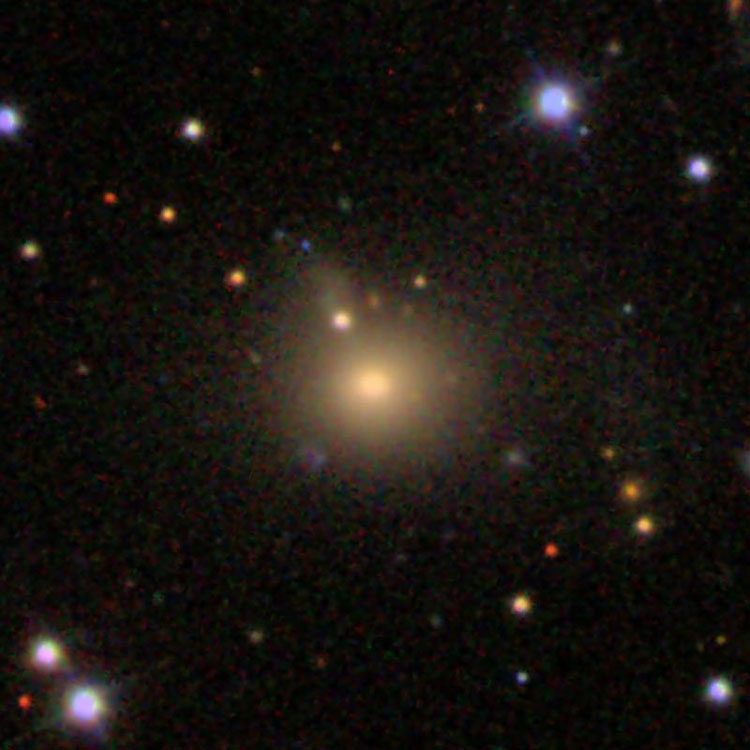
Above, a 2.4 arcmin wide closeup of IC 495
Below, a 12 arcmin wide region centered on the galaxy
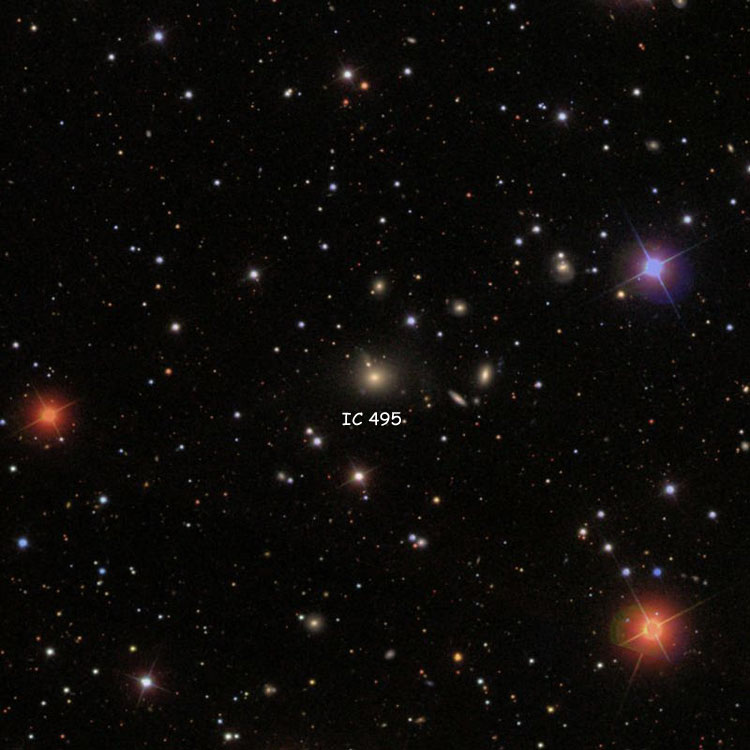
IC 496 (= PGC 22903 + PGC 93095, and = IC 2229)
Discovered (Mar 2, 1892) by Stephane Javelle (and later listed as IC 496)
Discovered (Feb 11, 1896) by Stephane Javelle (and later listed as IC 2229)
A triplet of galaxies in Cancer
PGC 93095 = A 15th-magnitude lenticular galaxy (type S0?) at RA 08 09 44.2, Dec +25 52 54
PGC 22903 = A 16th-magnitude pair of galaxies (type S pec + Irr pec) at RA 08 09 45.5, Dec +25 52 50
Per Dreyer, IC 496 (Javelle #152, 1860 RA 08 01 16, NPD 63 42.9) is "pretty faint, small, extended east-west, a little brighter middle". The position precesses to RA 08 09 44.5, Dec +25 52 45, between the two objects listed above, so the identification of IC 496 as the brighter or both of them is certain. Various references list one or the other as IC 496 and ignore the other, while which is chosen as IC 496 seems more or less random. As noted by Corwin, Javelle's description of the nebula as extended east-west, when each of the objects is oriented north-south, may mean (and I think almost certainly does mean) that both should be treated as comprising IC 496, hence my decision to so do here. (See IC 2229 for a discussion of the duplicate listing.)
Based on a recessional velocity of 7690 km/sec, PGC 93095 is about 360 million light years away. Given that and its apparent size of 0.55 by 0.25 arcmin, it is about 55 thousand light years across. Its distance is essentially the same as that of PGC 22903, so they are almost certainly companions; but there is no sign of gravitational interaction between them, so they are probably not as close as they appear, and are more likely to be a few million light years apart than the mere tens or hundreds of thousands of light-years separation that their nearly identical direction might imply.
PGC 22903 is an interacting pair of galaxies, so distorted by their (probable) collision and/or merger that no standard classification appears to fit either. Based on their recessional velocity of 7540 km/sec, they are about 350 million light years away, but since peculiar (non-Hubble expansion) velocities can easily exceed the 150 km/sec difference in velocity between PGC 22903 and PGC 93095, their Hubble distances are for all practical purposes identical. Still, as noted above they cannot be as close as they appear, as there is no sign of interaction between them, so they probably do differ in distance by a few million light years, though not necessarily by as much as the nearly 10 million light year difference based on their recessional velocities. Given its apparent size of 0.4 by 0.4 arcmin, the pair of galaxies listed as PGC 22903 is about 40 thousand light years across.
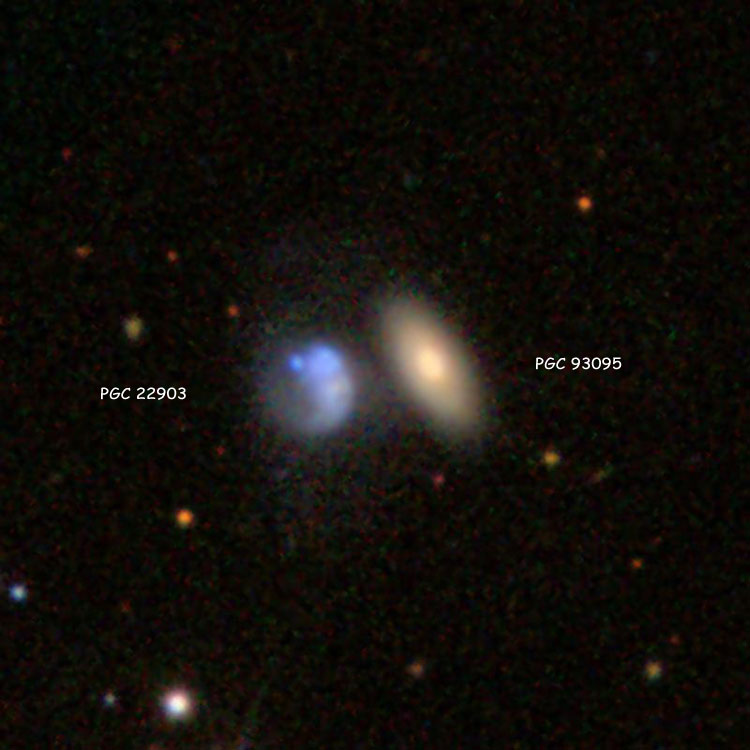
Above, a 2.4 arcmin wide closeup of the group of galaxies listed as IC 496
Below, a 12 arcmin wide region centered on the group

IC 497 (= PGC 22918)
Discovered (Mar 2, 1892) by Stephane Javelle (153)
A 14th-magnitude lenticular galaxy (type S0/a?) in Cancer (RA 08 10 06.1, Dec +24 55 20)
Apparent size 0.9 by 0.5 arcmin.

Above, a 2.4 arcmin wide closeup of IC 497
Below, a 12 arcmin wide region centered on the galaxy
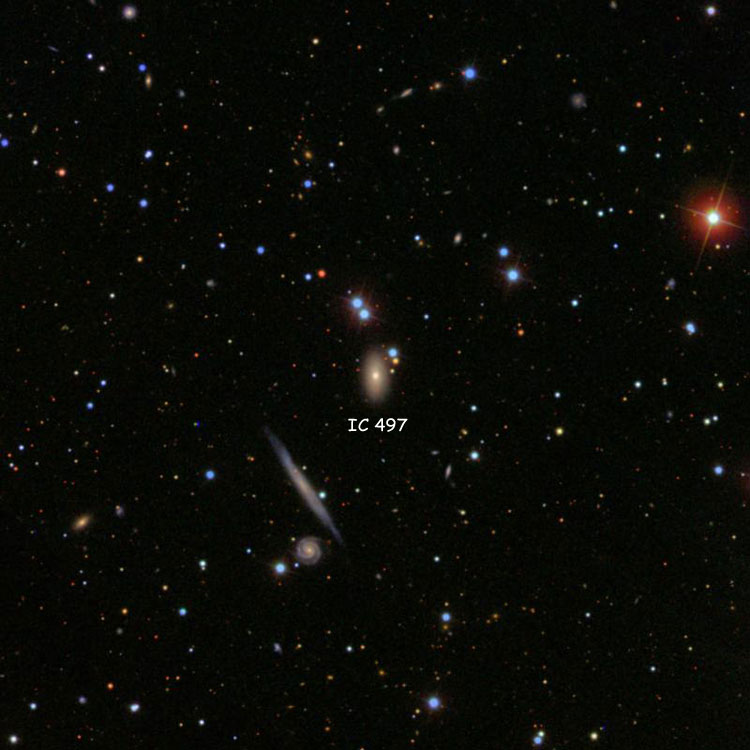
IC 498 (= PGC 22895)
Discovered (Nov 11, 1888) by Rudolf Spitaler
A 14th-magnitude spiral galaxy (type SABb?) in Canis Minor (RA 08 09 30.3, Dec +05 16 50)
Apparent size 1.2 by 1.2 arcmin.
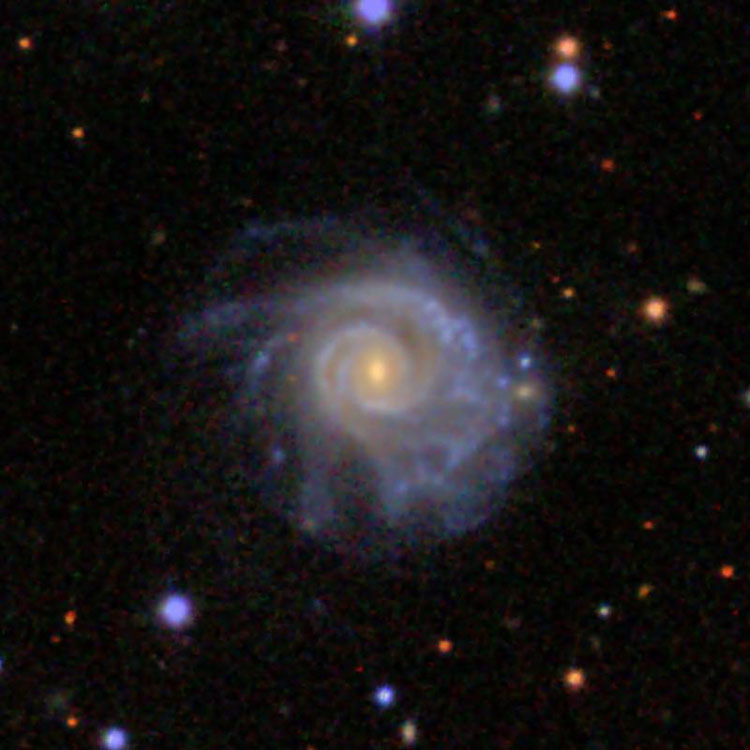
Above, a 2.4 arcmin wide closeup of IC 498
Below, a 12 arcmin wide region centered on the galaxy
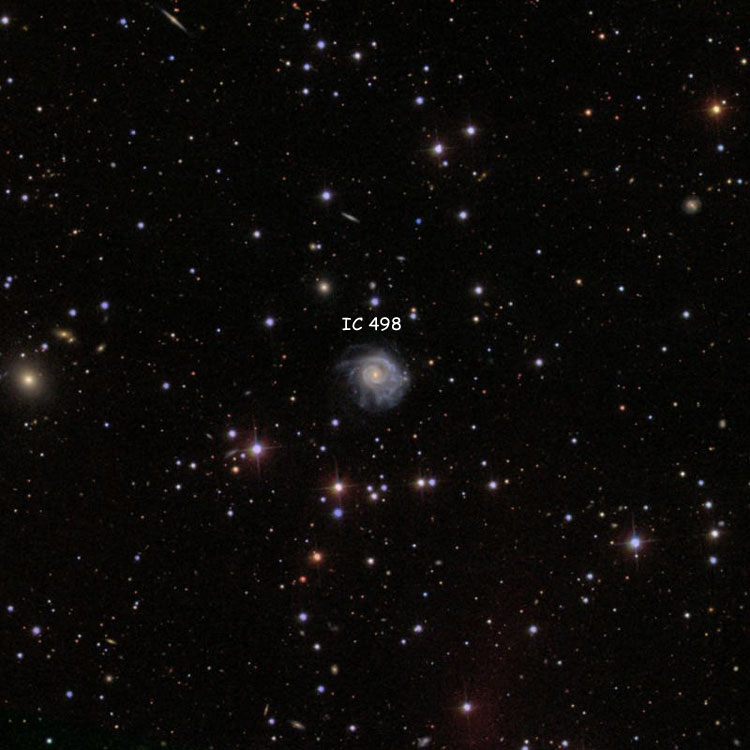
IC 499 (= PGC 24602)
Discovered (Sep 8, 1890) by William Denning (9)
A 13th-magnitude spiral galaxy (type S0/a?) in Camelopardalis (RA 08 45 17.3, Dec +85 44 26)
Apparent size 2.0 by 1.1 arcmin.

Above, a 2.4 arcmin wide closeup of IC 499
Below, a 12 arcmin wide region centered on the galaxy
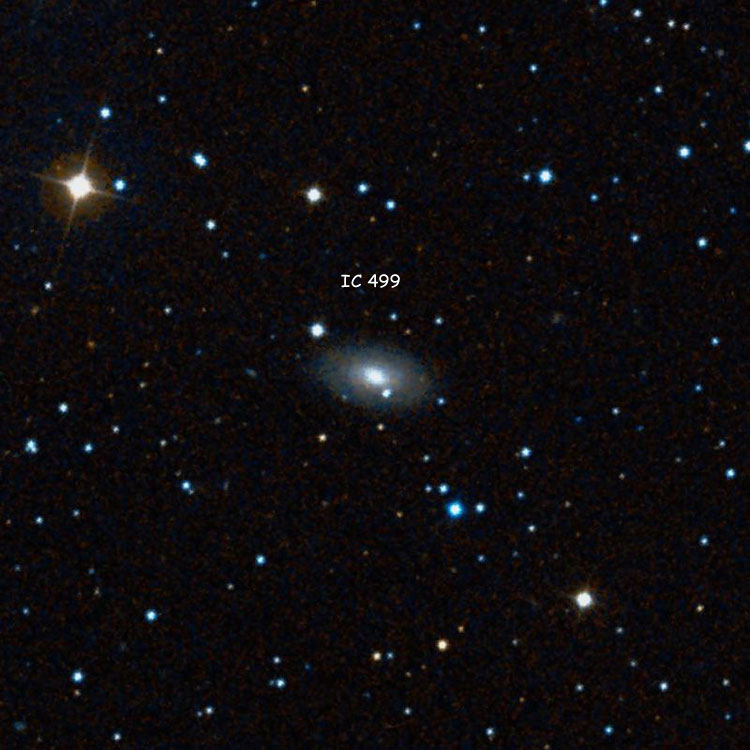
|